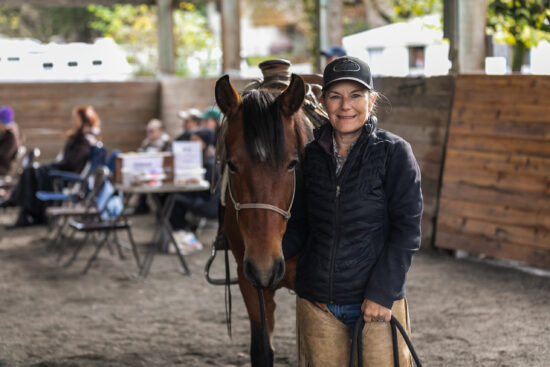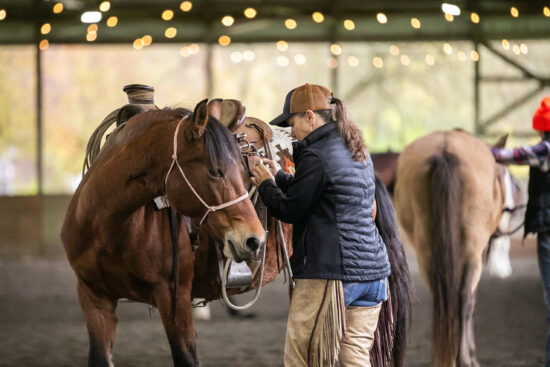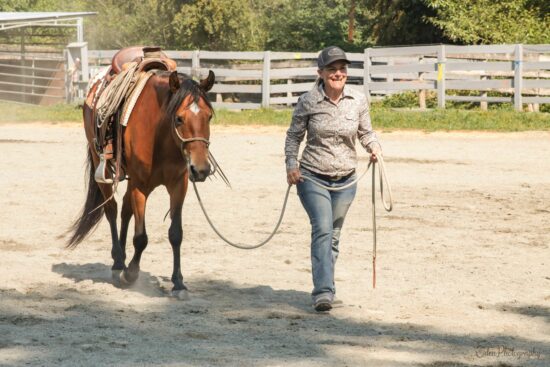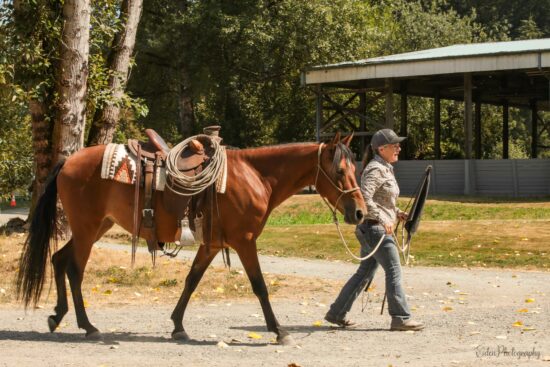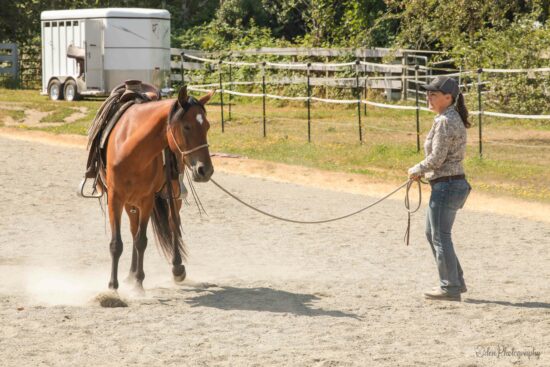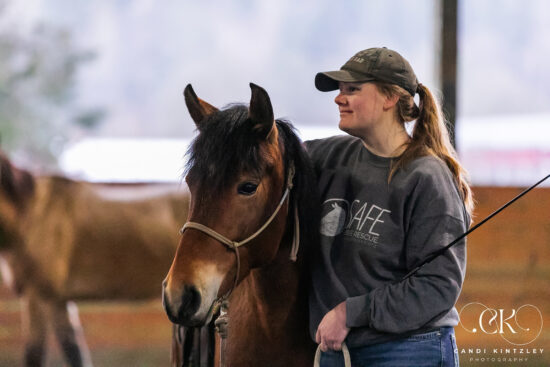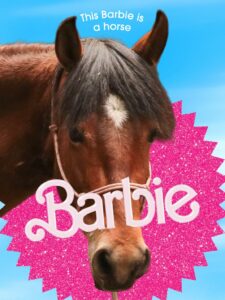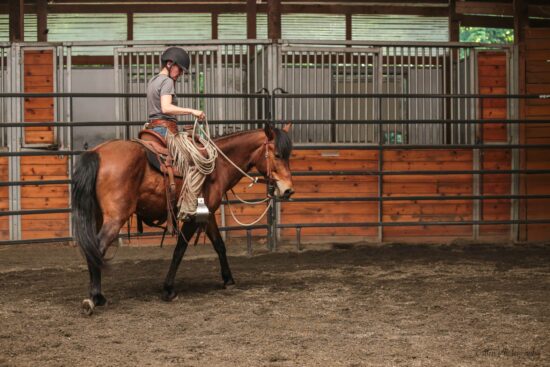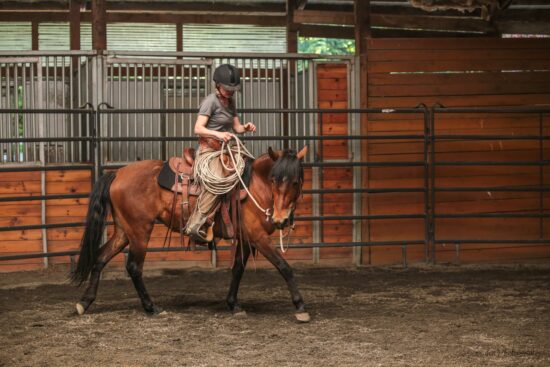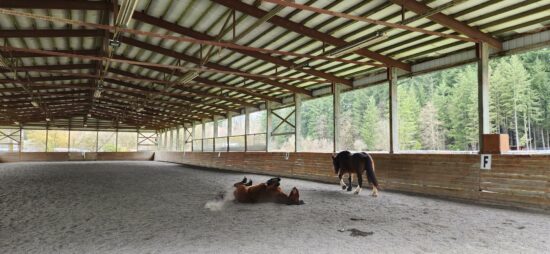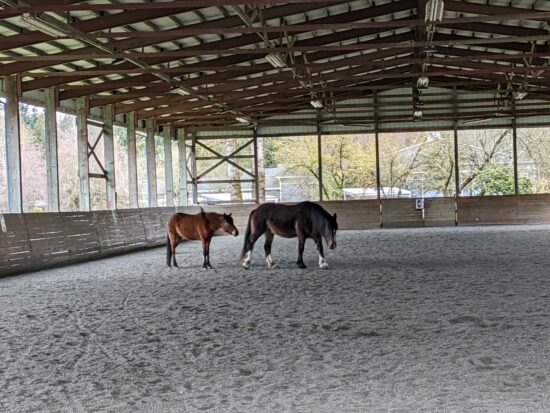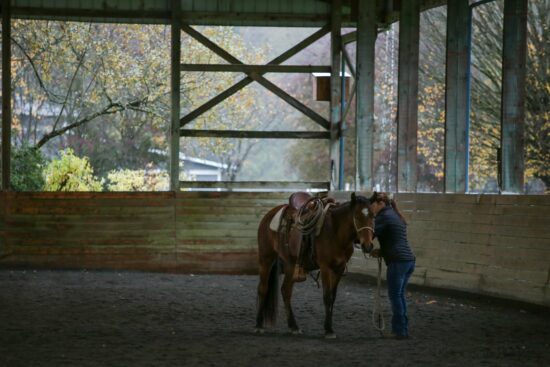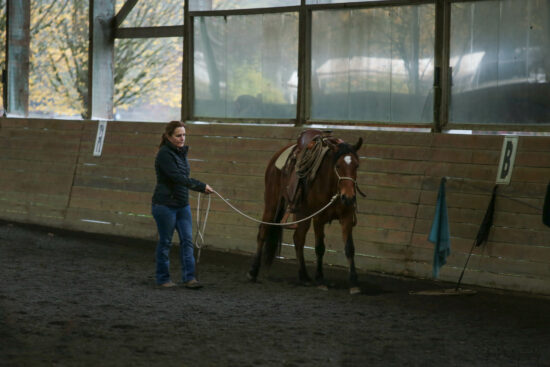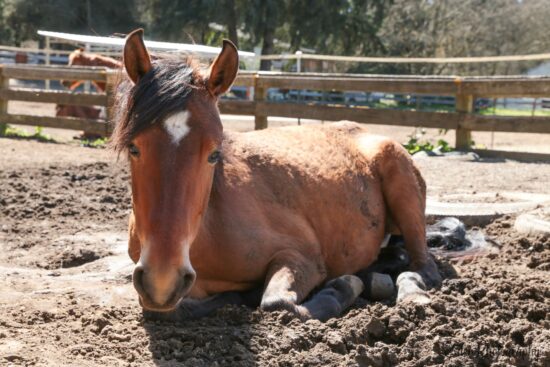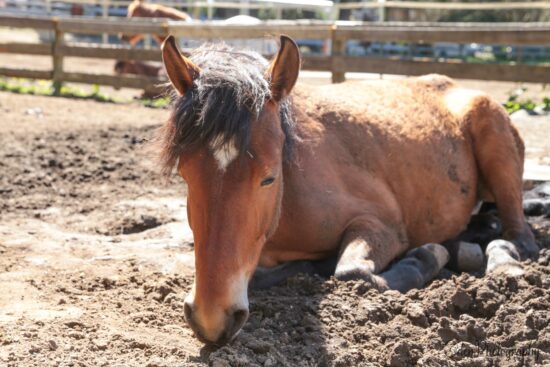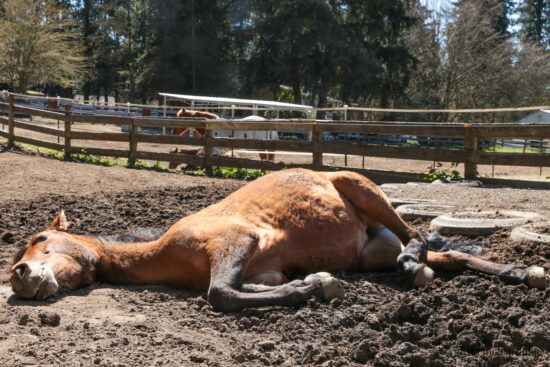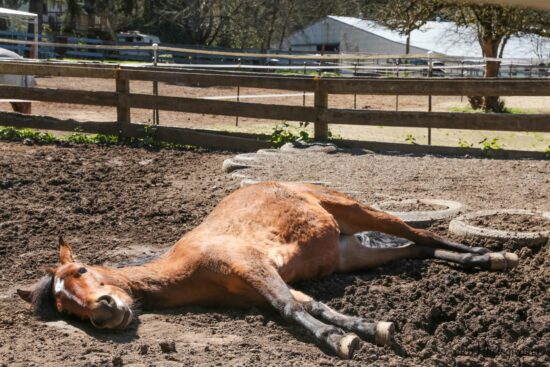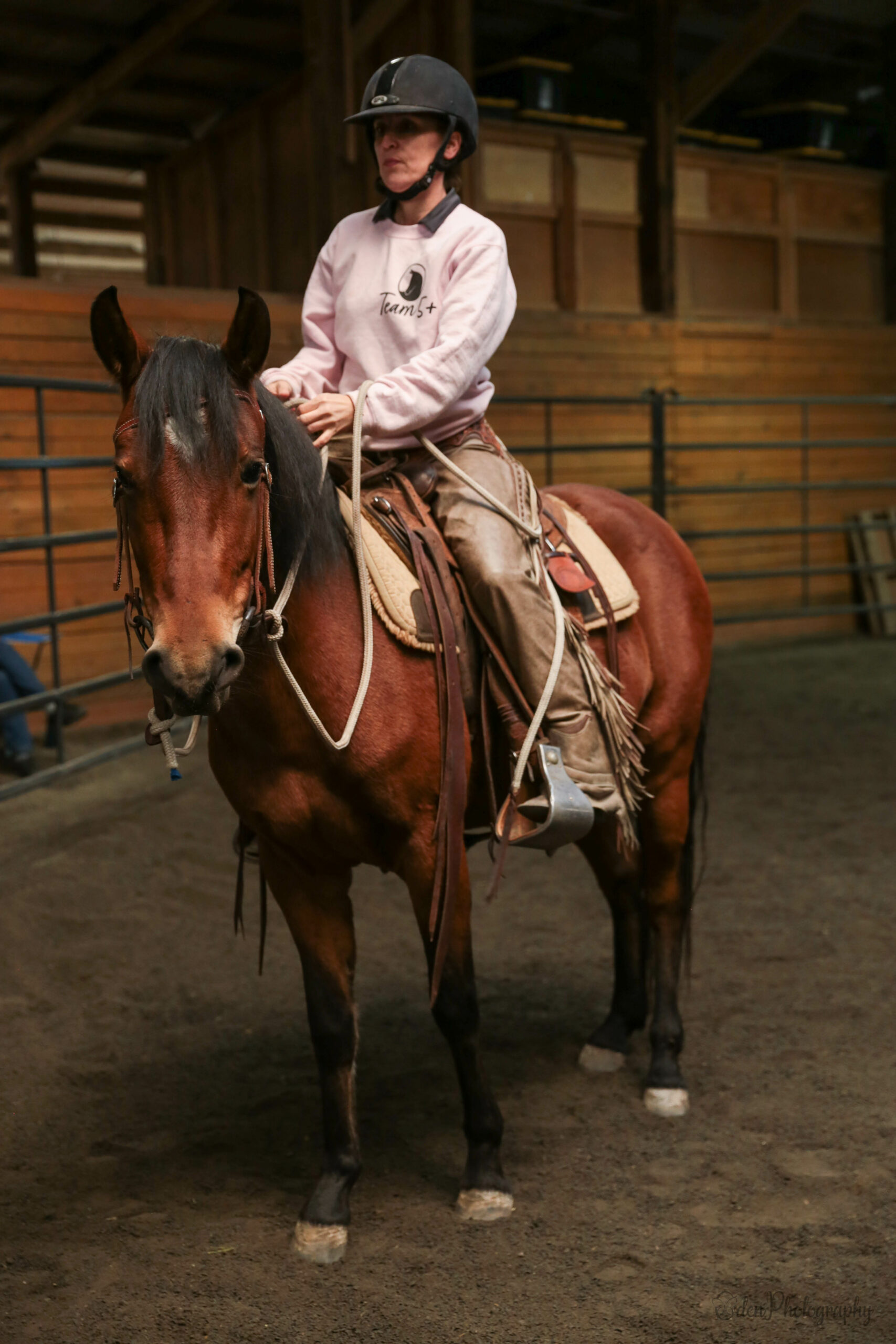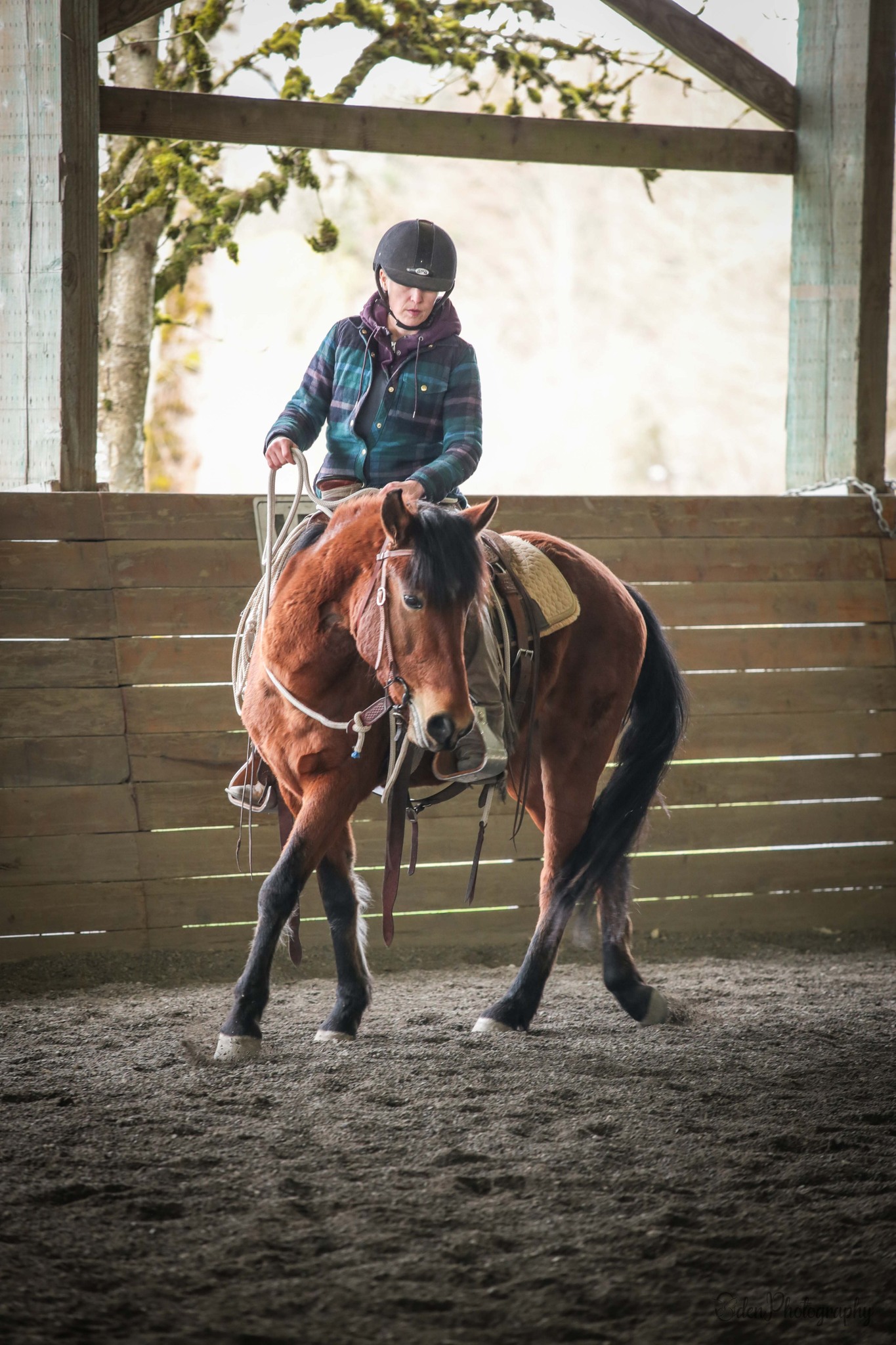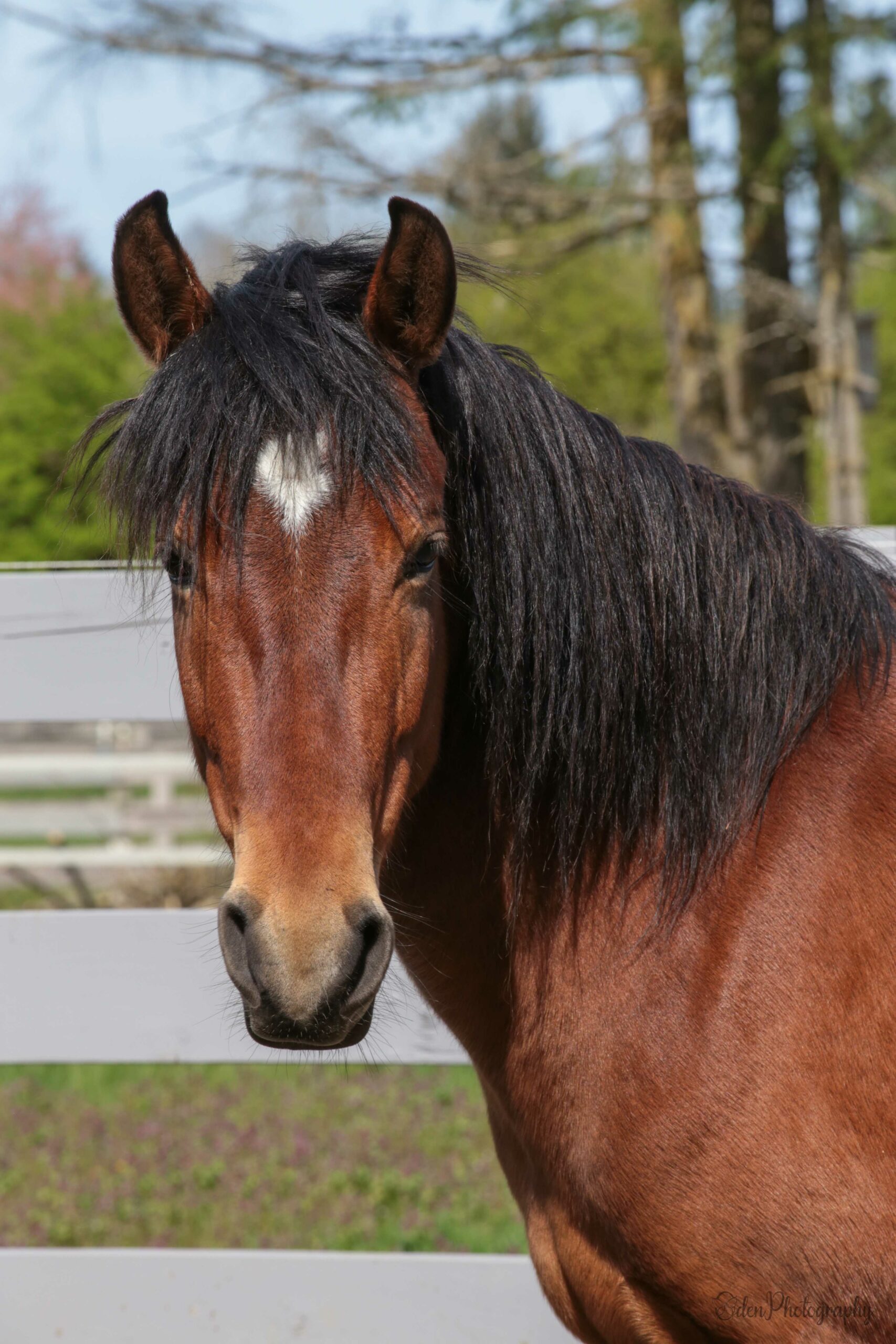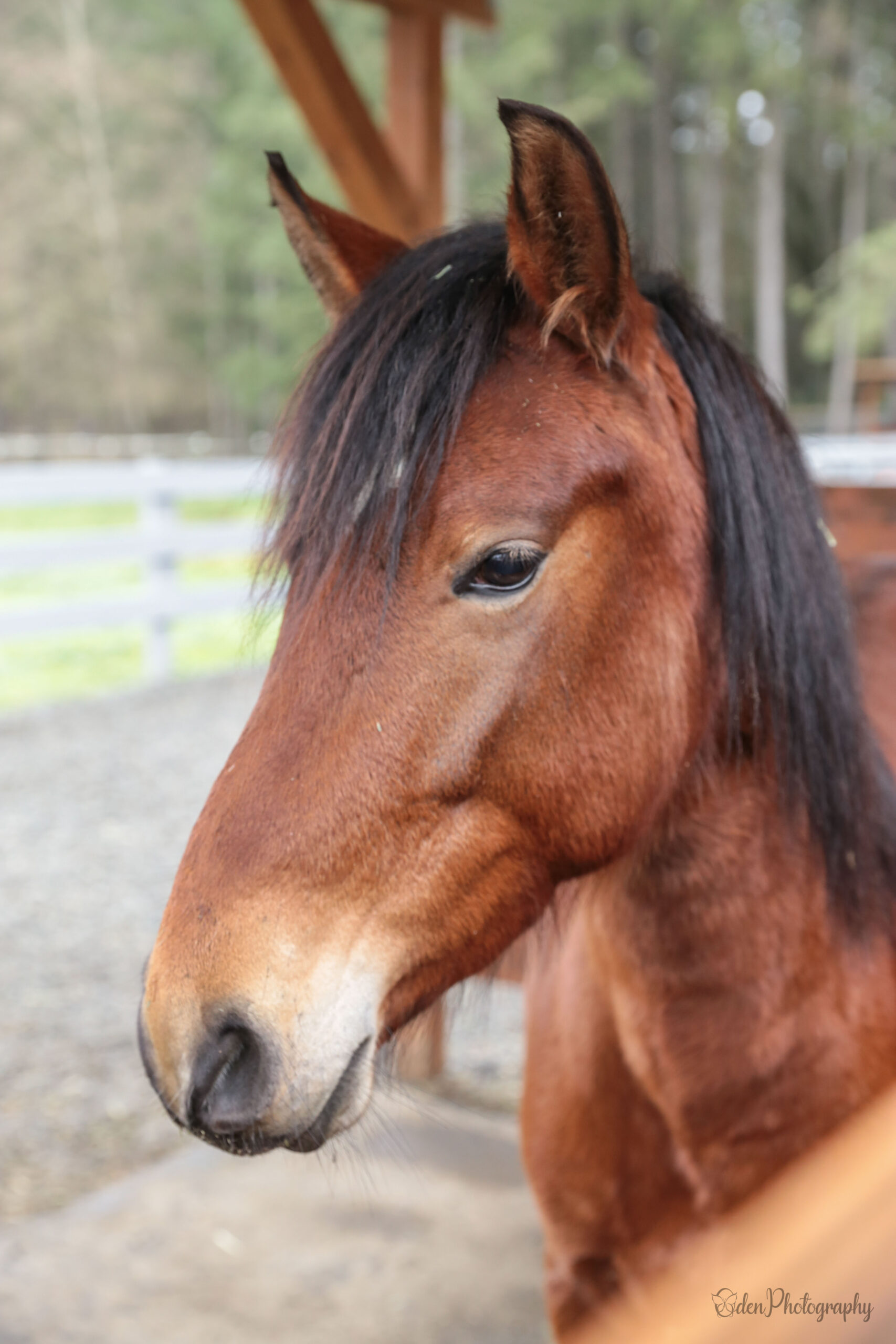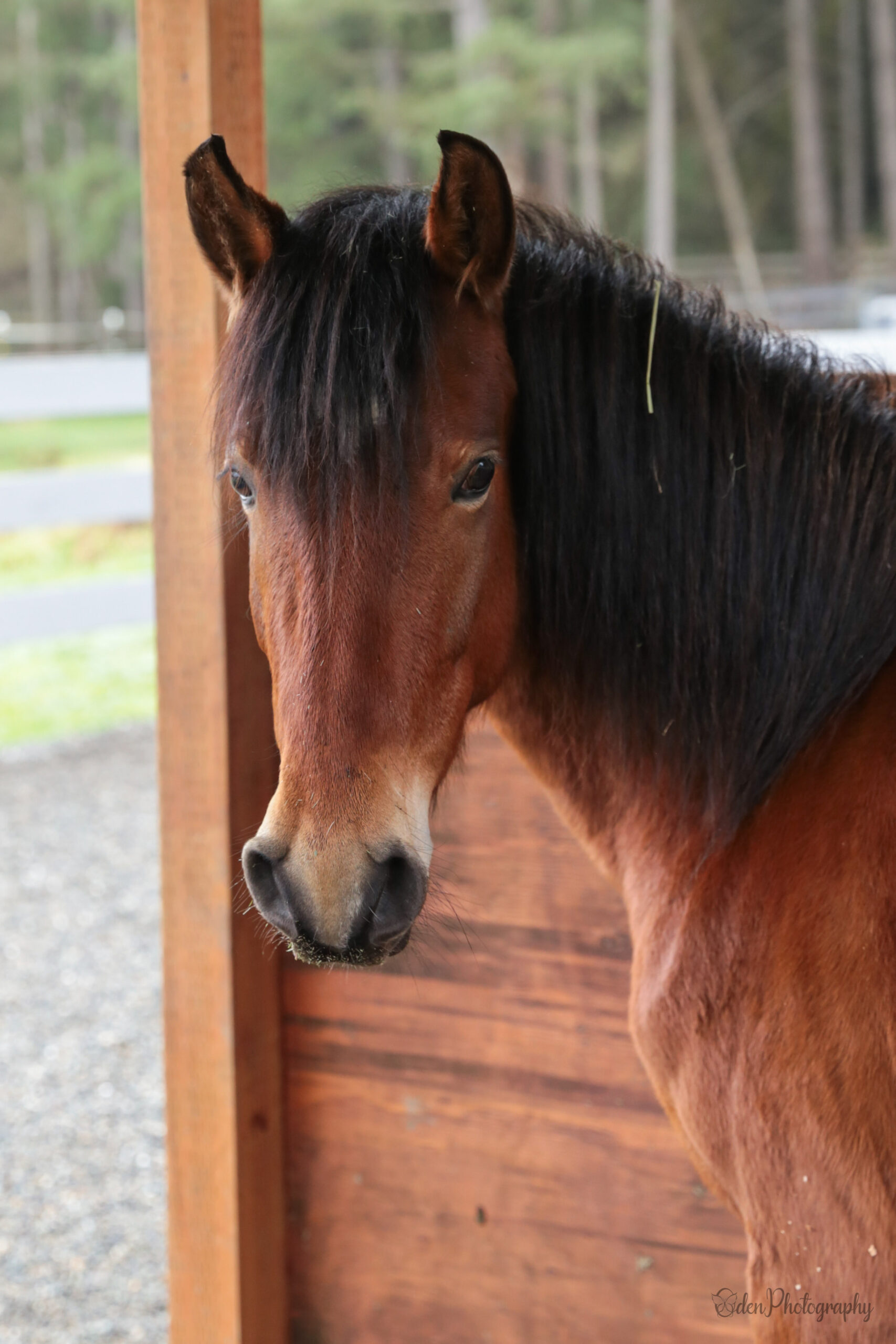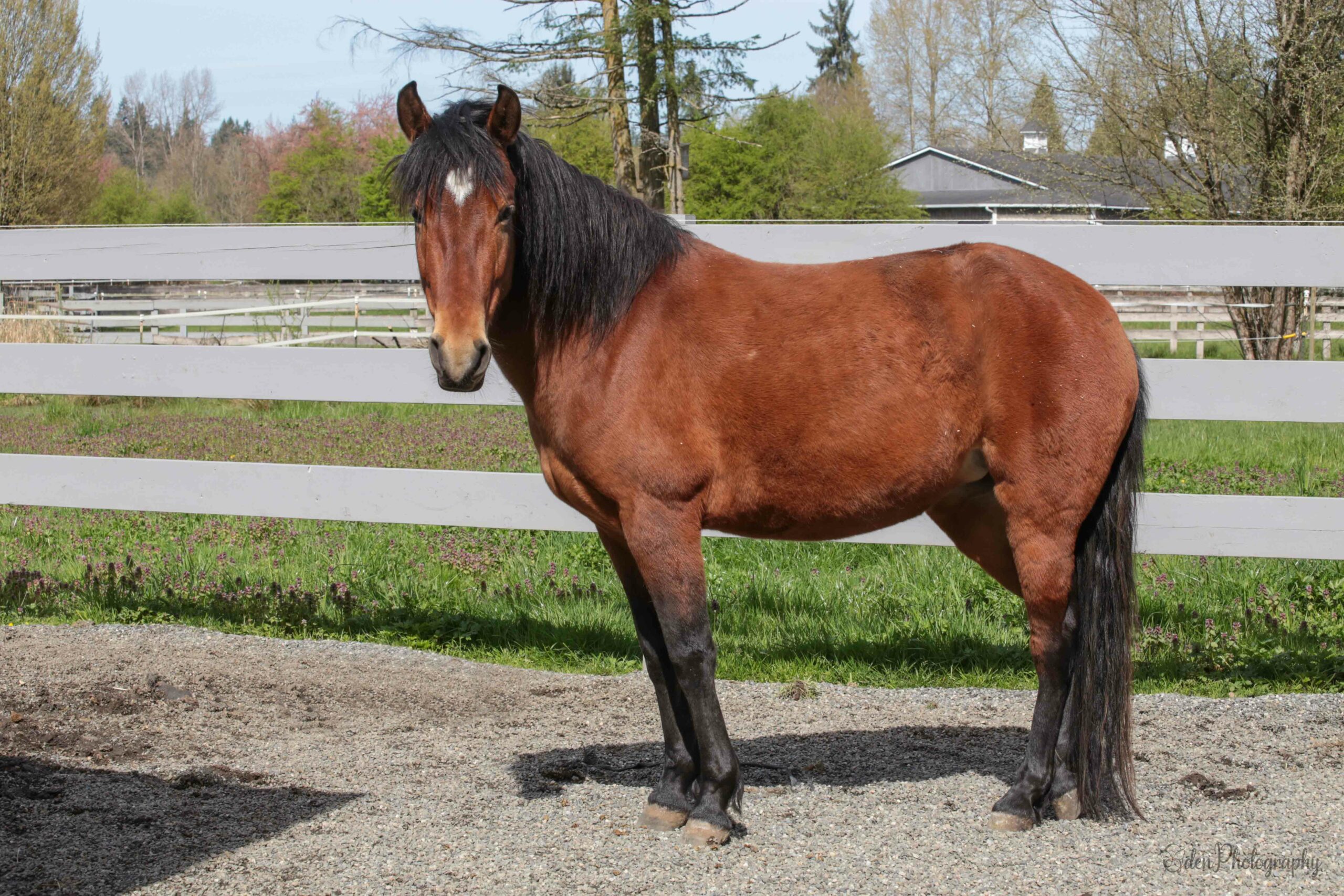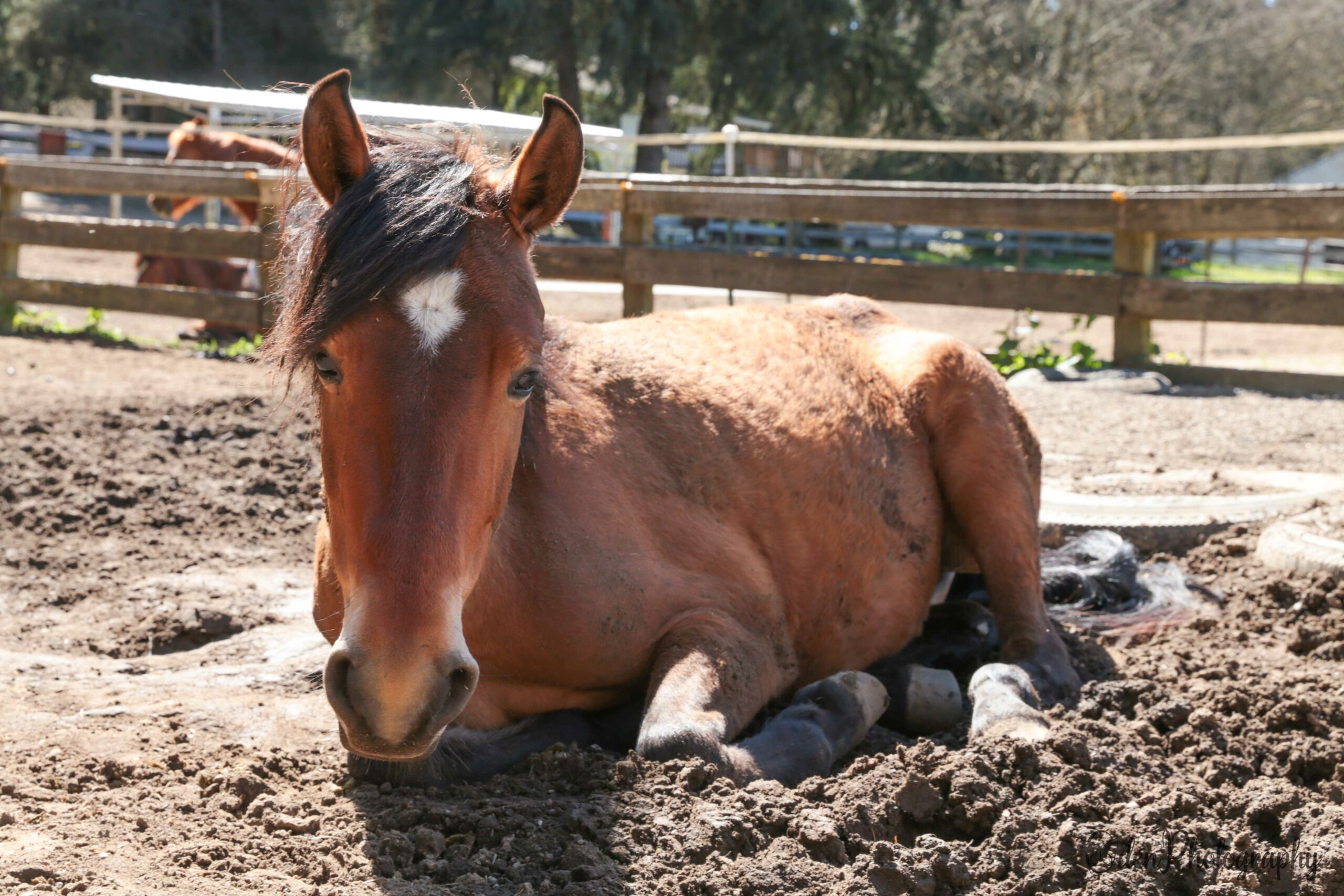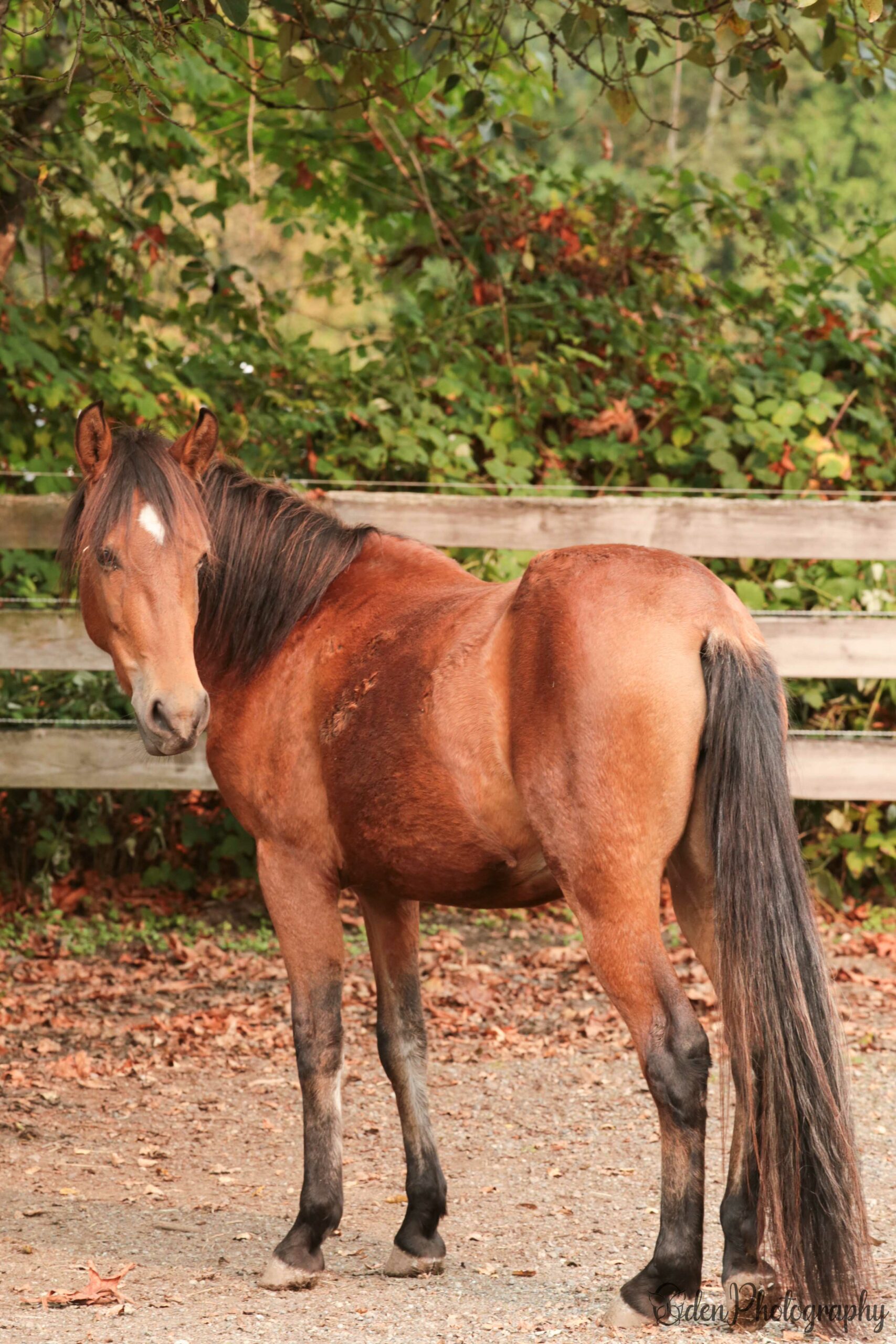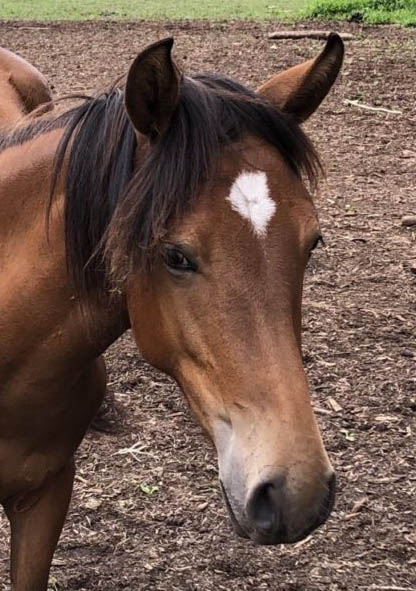Barb
2019 Yakima Reservation mare
Suitability: For Intermediate Rider
Color: bay
Markings: star
Height: 13.3 hh
Weight: 708 lbs
Adoption Fee: $2500
Barb is one of 24 wild Yakima Reservation horses seized in December 2019 by King County Sheriff’s Office, in cooperation with Regional Animal Services of King County and SAFE. Since her rescue as a filly three years ago, Barb has grown into a smart, curious, and playful riding partner—but she’s still plenty green and requires an experienced rider to bring her comfort as she learns new things. She’s been a superstar at SAFE’s on-site clinics and is ready to be introduced to trails with the right rider. She is not suitable as a child’s mount since she needs some time to grow and mature herself.
All SAFE horses are adopted with a no-breeding clause, no exceptions.
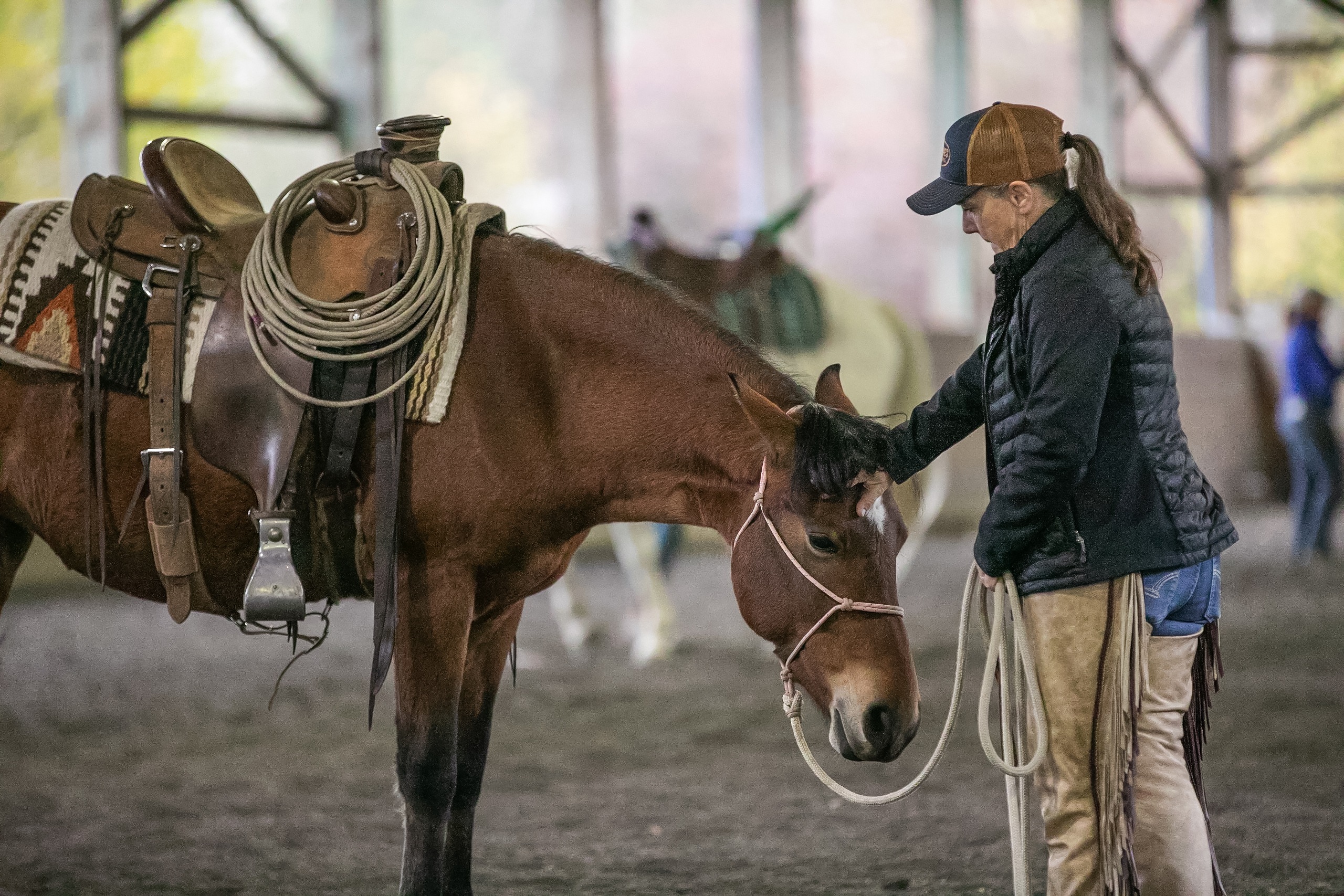
October Joel Conner Clinic Report: Barb
Candi K has been working alongside Barb for the last year, and recently participated in the groundwork portion of Joel’s final SAFE clinic of 2024. Here’s what she has to say about working alongside this special mare:
“It seems like just yesterday that Barb and I started working together and now it is almost the end of 2024. We started in the dark months of winter, welcomed the spring, basked in the sunrays of summer, and watched the colors change in fall. It has been a season of change for both of us. We participated in 4 Joel Conner Horsemanship Clinics at SAFE and the Buck Brannaman Horsemanship Clinic in Ellensburg.
It is already a known fact that this mare may be small, but she is mighty. Beyond those brown deep eyes and beautiful bay coat she packs a powerful engine. This clinic we spent a considerable amount of time on hindquarters as this the key to success in the horsemanship journey.
We were not good dance partners at the beginning of clinic. She continually challenged my space and honestly, I was getting frustrated. After 8 months of working together I felt like we slipped backwards. Then I became very clear to me even though we had been working all this time I still had not gotten her to be free of her feet and feel of me.
While other participants worked on other skills we focused mainly on one goal. Hindquarters and making her move away from me. Over the three days her understanding of my space vs. her space changed and improved considerably.
You could say it was back to the basics for both of us. It paid off in spades though. Barb had Monday off and on Tuesday she was a different dance partner. She kept her distance in the unified circle and her hindquarters were so much better. It was an unbelievably rewarding moment for both of us.
Barb is a work in progress. She is not easy by any means, but she will prove to be a good partner for someone who is willing to commit to her. She needs someone who will put in the work not just part time but all the time. Barb may be small but is smart, capable and has an engine to take you anywhere you want to go.”
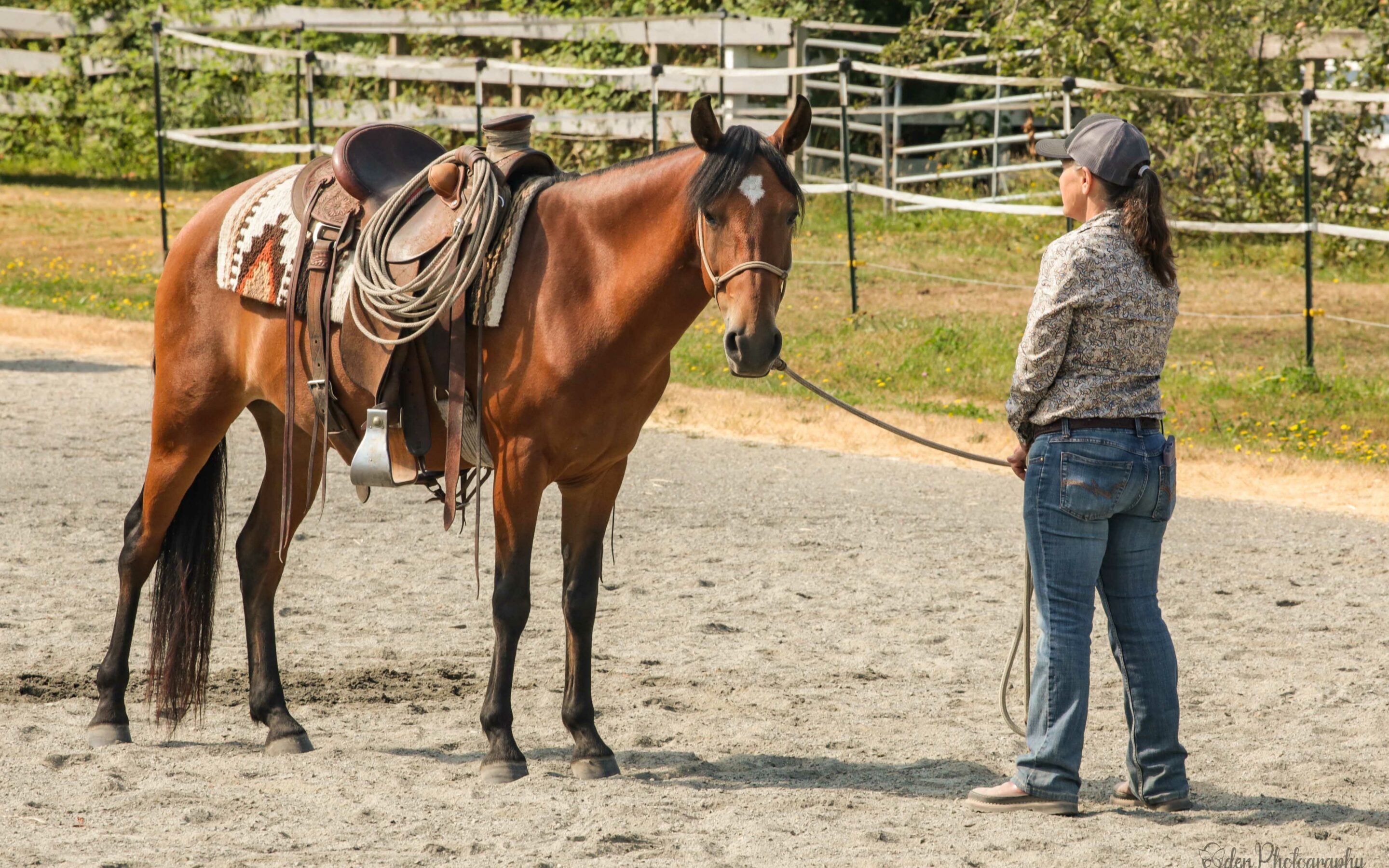
August Joel Conner Clinic Report: Barb
“Working On The Volume Dial” by Candi K
“The August Joel Conner Clinic brought another opportunity for Barb and I to work on our connection and skills in the world of horsemanship. We enjoyed being in the outdoor arena where there were a lot of horses and plenty of other distractions to add to the mix. She was calm and stood patiently with me as we listened to Joel instruct.
Barb and I are working on the volume dial. Her energy often indicates she is at high decibel levels. I on the other hand can have the volume of a cricket. Over the span of the three days I learned to pump up my volume to show Barb I am a confident dance partner. Getting her to move off my energy, move away me when I ask and have her respectfully respond to my asks were all part of our classwork.
We concentrated on moving the hindquarters most of the clinic as it is the most important foundation of all. Fine tuning her backup through a variety of ways and bending softly from the ground are all some of her other weekend accomplishments.
Barb definitely believes she independent and in charge. Underneath the layers though she is a willing partner if you take the lead in the dance. She isn’t push button by any means. She will continue to grow, learn and thrive with the right partner. Until then I am excited to see what we can accomplish together.”
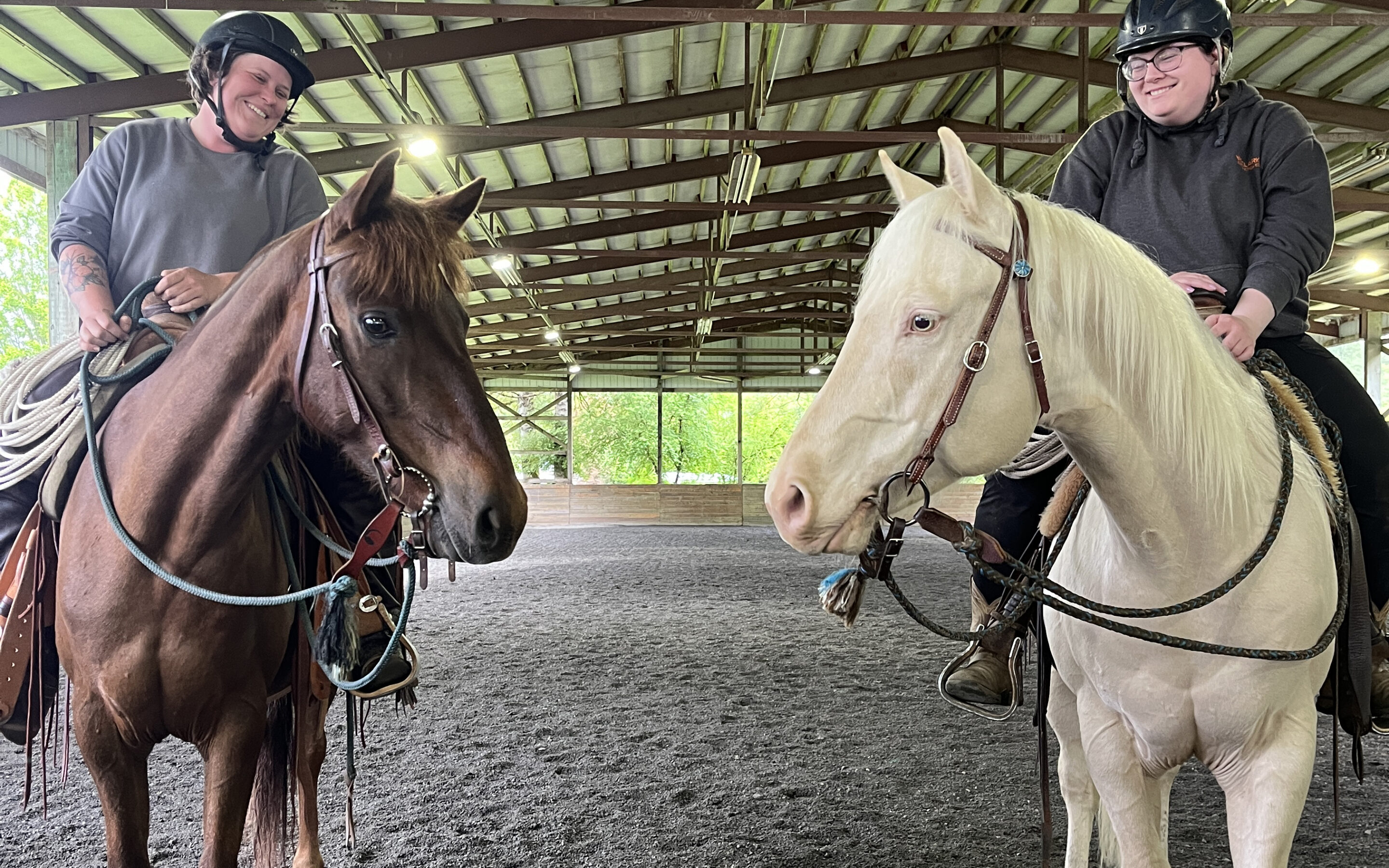
SAFE at Buck
Buck Brannaman is headed to Washington for the next two weekends, and the SAFE horses will be joining him at his clinics in Spanaway and Ellensburg. This is a great opportunity for the horses to get experience off-property while furthering their education with a phenomenal horseman.
Come see:
Esme, 2015 Yakima Reservation mare, at Spanaway and Ellensburg
Jupiter, 2017 AQHA gelding, at Spanaway and Ellensburg
Edward, 2014 Yakima Reservation gelding, at Spanaway and Ellensburg
Veronica, 2015 Yakima Reservation mare, at Spanaway
Moshi, 2016 pony mare, at Spanaway
Barb, 2019 Yakima Reservation mare, at Ellensburg
Artie, 2013 Yakima Reservation gelding, at Ellensburg
Tiva, 2011 Yakima Reservation mare, at Ellensburg
Auditors welcome, $30/day
Spanaway dates are June 21–23 at the Tacoma Unit, Horsemanship 1 from 9–12 & Horsemanship 1.5 from 1:30–4:30
Ellensburg dates are June 28–30 at the Rodeo Grounds of the Kittitas Event Center, Foundations from 9–12 & Horsemanship 1 from 1:30–4:30
You can find out more information on Buck’s site: https://brannaman.com/bb-clinic-si.html
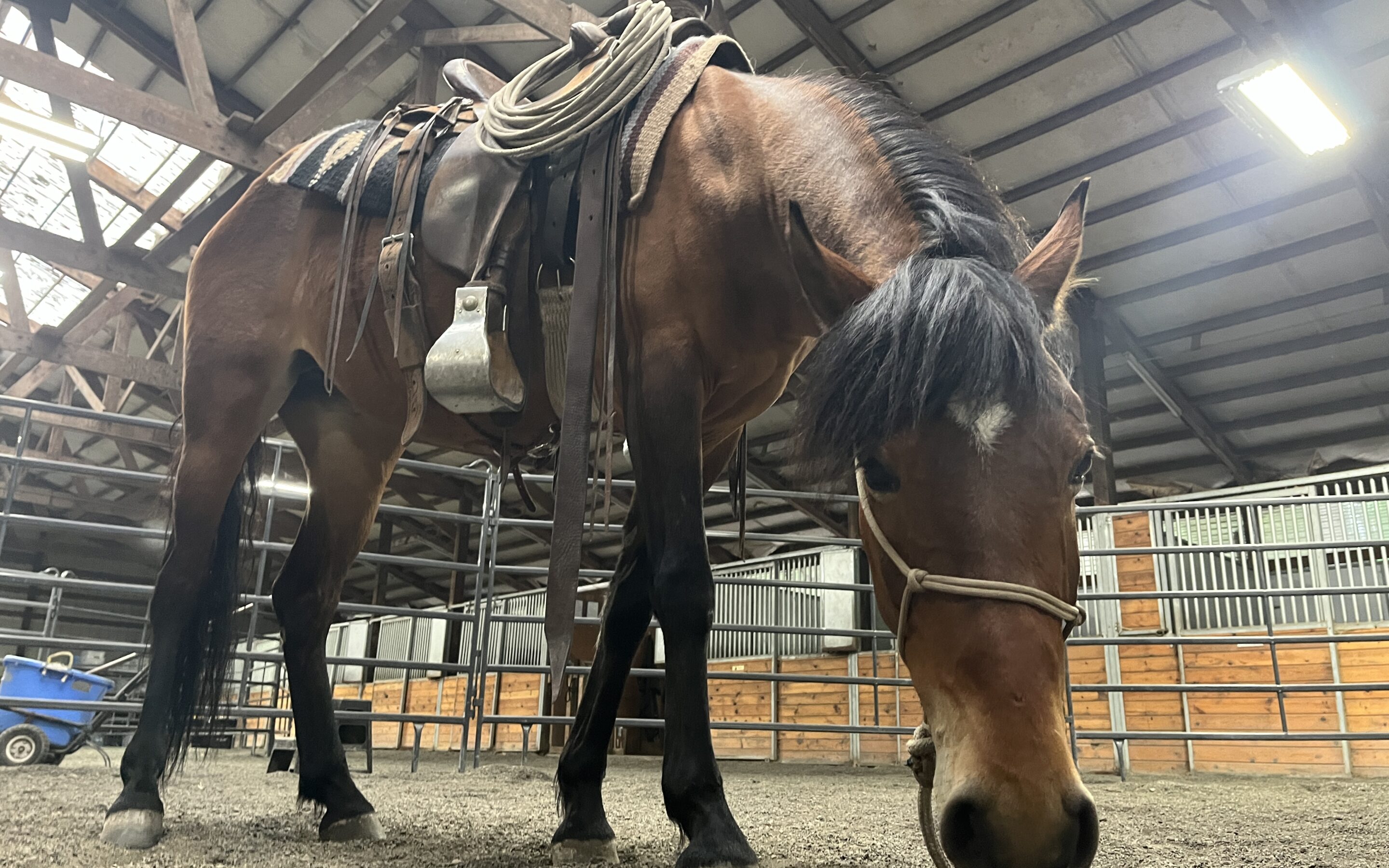
Back in the saddle with Barb
As you pass by her paddock, Barb nickers at the gate, a little bay siren enticing you closer. It is hard to divine what, exactly, she wants, once she has you. Likely to be let out and left to her own devices. Barb would make an excellent automatic lawn mower, if only someone would allow her to live out her dream.
Barb was between riders for a bit, and had a bit of a vacation, but after a period of muscling up on the ground, was easy to get back going under saddle. She knows her lines, just needs a bit more work on their delivery at times. I (Lily) have been ground working her in preparation for her work with a rider, and it has been an enlightening experience for me. One thing I have learned is that Barb loves competence. But she is also forgiving to those of us who chase it with a big ‘IN’ prefacing the word. She reminds me of a surly teenager on occasion, acquiescing to your request, but not happy about it. You are nagging her to take out the trash for the fifth time, and she’s really doing her best, so lay off, would ya? Barb just showcases what (some) other horses are better at internalizing, which makes her a pretty cool little pony. She really forces you to want to work on yourself and your ask, and when you’re doing something ‘right,’ she rewards you for it in spades. For me, working with Barb has been an exercise in refinement. She is not afraid to tell you when you need to adjust your volume, and she has a way better ear for it than you do. Or I do, rather, which has been interesting for me. I’m not quite there yet, but I’m getting better at it, and Barb is a big part of that. She does on occasion, especially after a weekend or few days off, get squirrely and sassy, needing a reminder of where her feet are and how she can use them to feel more secure, but she has come a long way even just since i began working with her in hooking on to a person and feeling of an ask.
Personality wise, she is a little goof. Sometimes, Barb wants to sniff your face. Warm breath on your cheek. Teeth that, while not necessarily sharp, are still powerful, hidden behind an easily retracted curtain of lip. It conjures up images of a dragon. Albeit, one who isn’t too hungry. Investigative, perhaps slightly dangerous? She seems more the former.
It has been a lot of fun learning from Barb, who is a very fun little horse herself. It will be a wonderful day when this cutie finds her person!
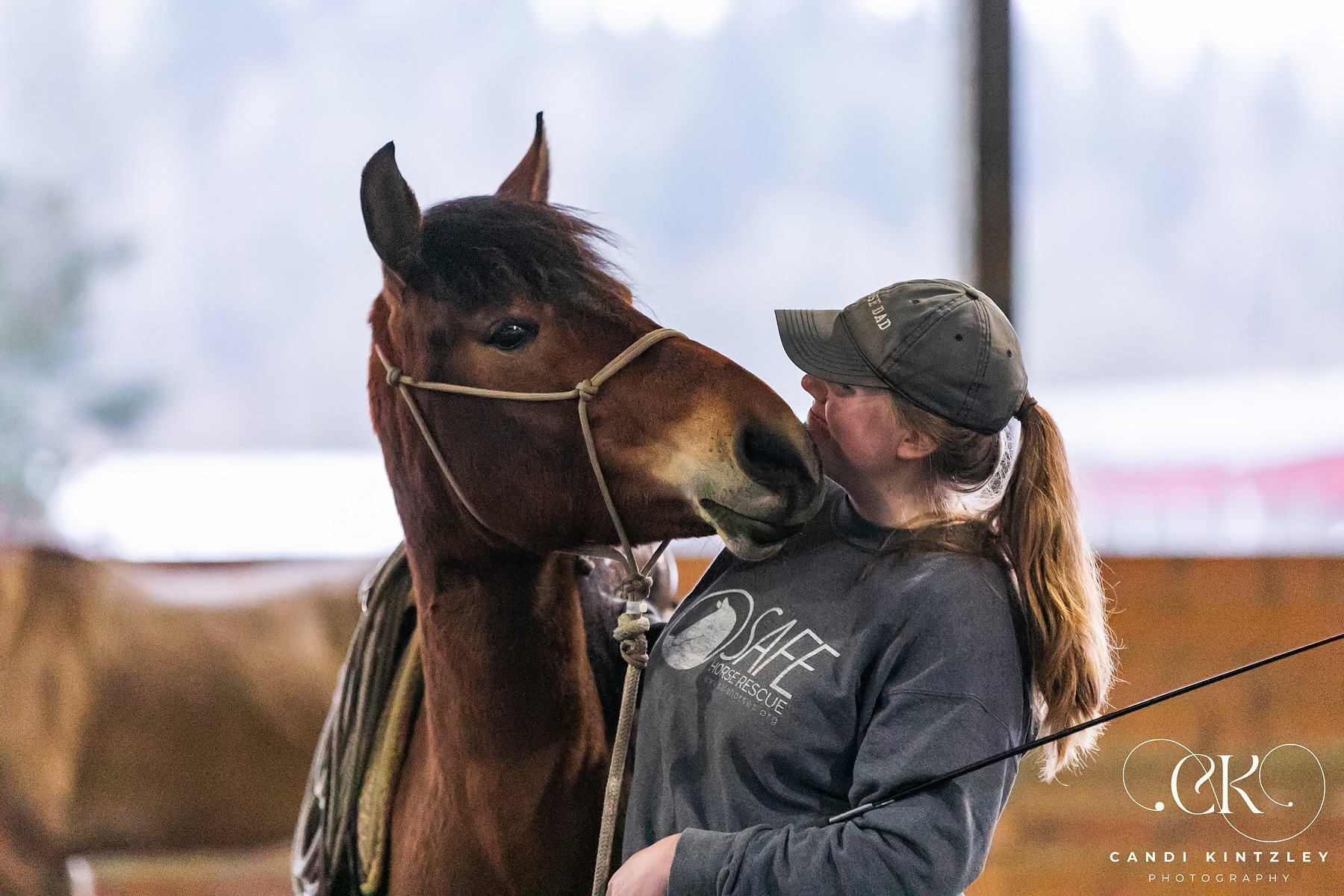
March Joel Conner Clinic Report: Barb
Barb is named so because back when she was a wild thing, veritably feral as part of the Fall City 40, she ran herself through a barbed wire fence. This would not be Barb’s only brush with fencing, as several years later she would tweak her back crawling out of her paddock. From those two sentences alone you can picture what a crafty, tough-as-nails, and determined horse Barb is. These traits bleed into every aspect of who she is, and why she is such a fun (and at times, challenging) horse to work with.
I have been working with Barb the past few months, and had the chance to bring her into the groundwork portion of the March Joel Conner clinic. When we first started working together, Barb was coming off a bit of a vacation, and she made that fact clear. Sure, she would go forward, but with the intensity and drama of a rocket being launched — not matching my feel at all. When I’d send her out loose, she’d go full ‘hamster at 3AM on a wheel,’ running mach-10 around the round pen, squashing all my attempts to get her attention and draw her in. Working with Barb was an exercise in not only showing her that I meant something, but also in leveling my own patience as she performed her antics.
But with time and consistency, Barb and I settled into a routine and a better understanding of one another. By the time the clinic came around, there was more feel between us, and we were able to work on more than just trying to get her with me.
Barb is a horse who, when she feels unable to move her feet, reacts in a major way. The fact that she has stopped exploding as much gives me hope that I am actually getting to her feet, and she is freeing up a bit more. Over the clinic weekend, we worked a lot on hindquarters, really getting her to reach under herself and engage her hind end. Her hindquarters to the left are still a bit ‘sticky,’ so she needs extra encouragement on that side. Barb still has a difficult time differentiating between when the flag means something and when it doesn’t, so we also worked on making that distinction more clear.
It is a lot of fun working with Barb, and I am proud of her progress. This spunky little cutie is going to make someone a fun horse, hopefully some day soon!
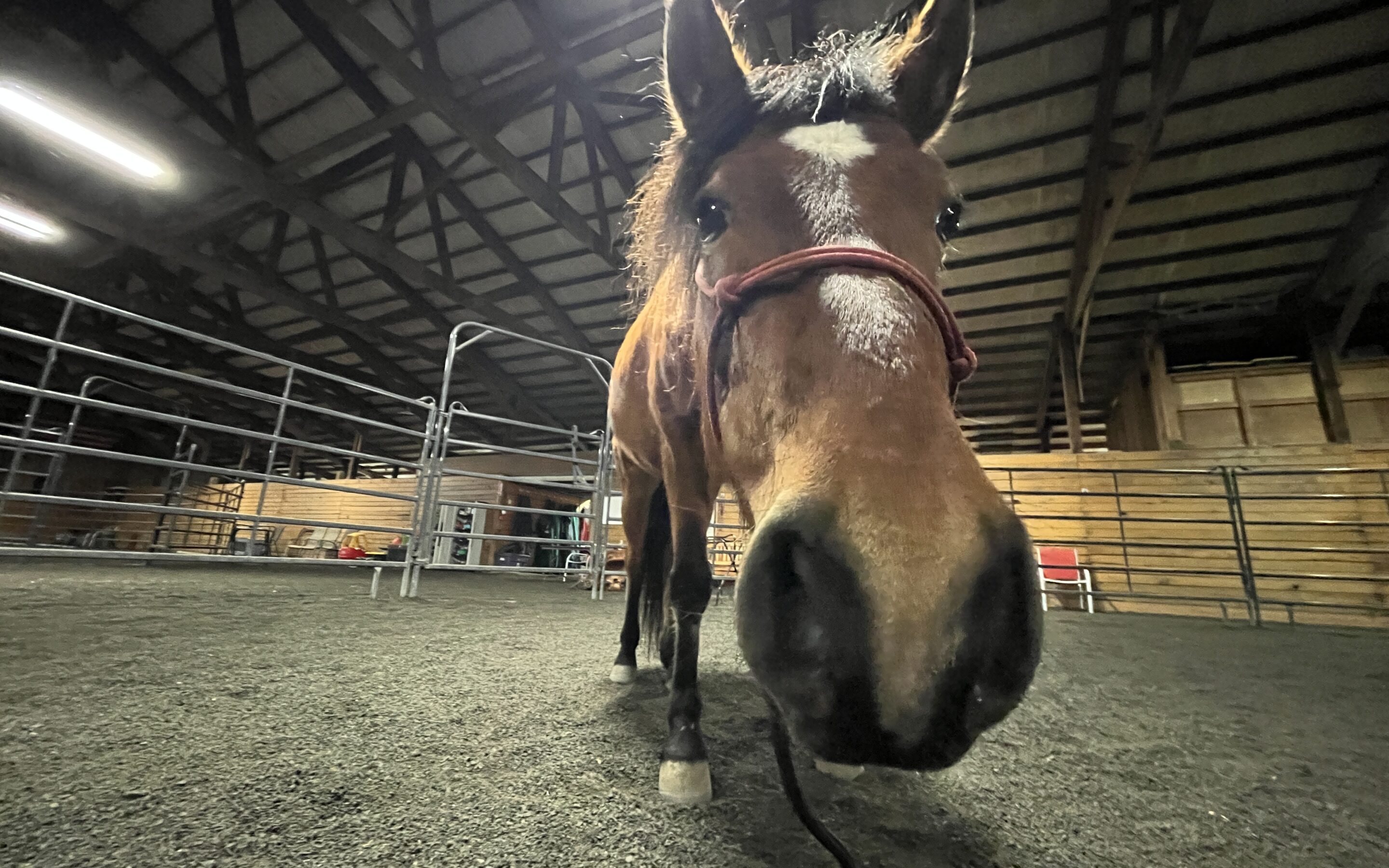
Working with Barb: A Reflection
Barb is a little bay lightning bolt, electricity on four fuzzy legs. I see Barb every day, but it was not until spending a few concentrated hours with her over the course of a few days that I was reminded how much personality lives in that petite body. Some might call a horse like Barb silly (on a good day) or frustrating (on a bad one), but the truth of it is that singular adjectives do not do her justice. Indeed, Barb can be silly, as she skates her nose along the ground on the walk to her stall, like a bloodhound following a scent (she’s scenting alright, sniffing for any errant hay she can inhale). She can also be frustrating, flinging open the window of her stall in order to make nasty faces at her neighbor (we have had to bungee her window shut to ensure no hijinks ensue when the HOA isn’t around to police her). But where Barb really excels is in something all horses do, which is being a mirror for us humans.
Barb wears her heart on her furry bay sleeve, and is not afraid to tell it like it is. Were Barb a human, she would be your painfully honest friend who delivers hard truths. Blunt? Maybe. But necessary? Yes.
This is really a post about the three consecutive days I worked with Barb, an update about how she’s doing and what we did, but it is also a reflection on the joy of horses and what they can tell us about ourselves.
The first evening that I let Barb out into the round pen, the intention being to send her around a bit to get some brain and body exercise, she took advantage of the few seconds I needed to hang up her halter and grab a flag to stop, drop, and roll. There was none of the spot-searching some horses do when looking for the best place to have a roll. No, Barb knew her time was limited, and got immediately to business. Popping up off the ground, she exploded into a canter, sending a buck in my direction to let me know exactly how she was feeling about the idea of having to ‘do work.’ From there, it became an exercise in trying to get her to hook on. Please note, this is not Barb’s first rodeo. While an injury waylaid her for a while, Barb was going well under saddle, walk trot lope in and out of the arena, on and off the property. She is no novice to being pushed around a round pen, and either because of or in spite of that fact, she does not make things simple for the human who is working with her. She races around, changing direction at will, kicking out, her body bent outward as though she is determined to not make any sort of eye contact. It is then an exercise in proving to Barb that you are actually worth paying attention to. Here is something that is both respectable and, yes, frustrating about this mare: she really is one to make you prove your credentials. She would like to know why it’s worth hooking on to you before she does it — running around willy-nilly with one’s own agenda is tremendous fun, after all. Even after you manage to get her ‘with’ you, the bond is tenuous. She demands you remain the most interesting, or she will find something else that is (and that, in a crushing blow to the ego, can sometimes even be dirt). Horses really ask you to be present, but Barb might as well demand it.
So when Barb does get ‘with you,’ it is quite rewarding. You also realize that, beneath that explosive surface is a horse who is somewhat dull. It seems impossible that she with so much life can be slow to respond, but it makes a bit more sense when you remember that life is on her own terms. When it is you asking Barb to go, she is much less enthused about the idea. Helping Barb through the dullness is about releasing her for the life you are requesting.
Once she was with me in a loose setting, we worked on the line. You might think that because we left on such a good spot loose that it would carry over, but such is not the case. On a halter, Barb immediately wants to trot off. She swings her head around, and you occasionally get the sense you are on the other line from a balloon that is quickly deflating. But like in the round pen, she needs you to prove to her that you are both worth paying attention to and reasonable. She is a horse who is quick to tell you if and when you are asking too much. The immediacy in which her ears fly backwards might as well say in plain English “you’re nagging.” But if you manage to time your releases appropriately, Barb transforms into a very chill little pony. It is a very cool opportunity to be able to work with a horse like Barb, for whom relaxation is something to be earned, not merely a default setting. At the end of day 1, Barb walked back to her stall with her head hung low.
On day 2, I was expecting the same sort of explosiveness I had seen the day before when I set her loose in the round pen, but she merely walked off calmly. It wasn’t until I pushed her up into a lope that she showed off her athletics. It still took a moment to turn her mind towards me, but it happened much sooner than the previous day. Day 3 followed a very similar course to day 2, but it took even less time to hook her on. Working on the line was a similar story, with her willingness to be present with me decreasing in the time it took from day to day. One of our core tenants when working with horses is to ‘observe, remember, compare, and adjust.’ It was very neat to be able to see the changes in Barb over the few days and work on having them appear sooner in subsequent sessions.
All horses are unique, but Barb has to be up there with one of the coolest gals I know! She is going to be a fun horse for someone who likes a big personality (and a cute face to boot!)
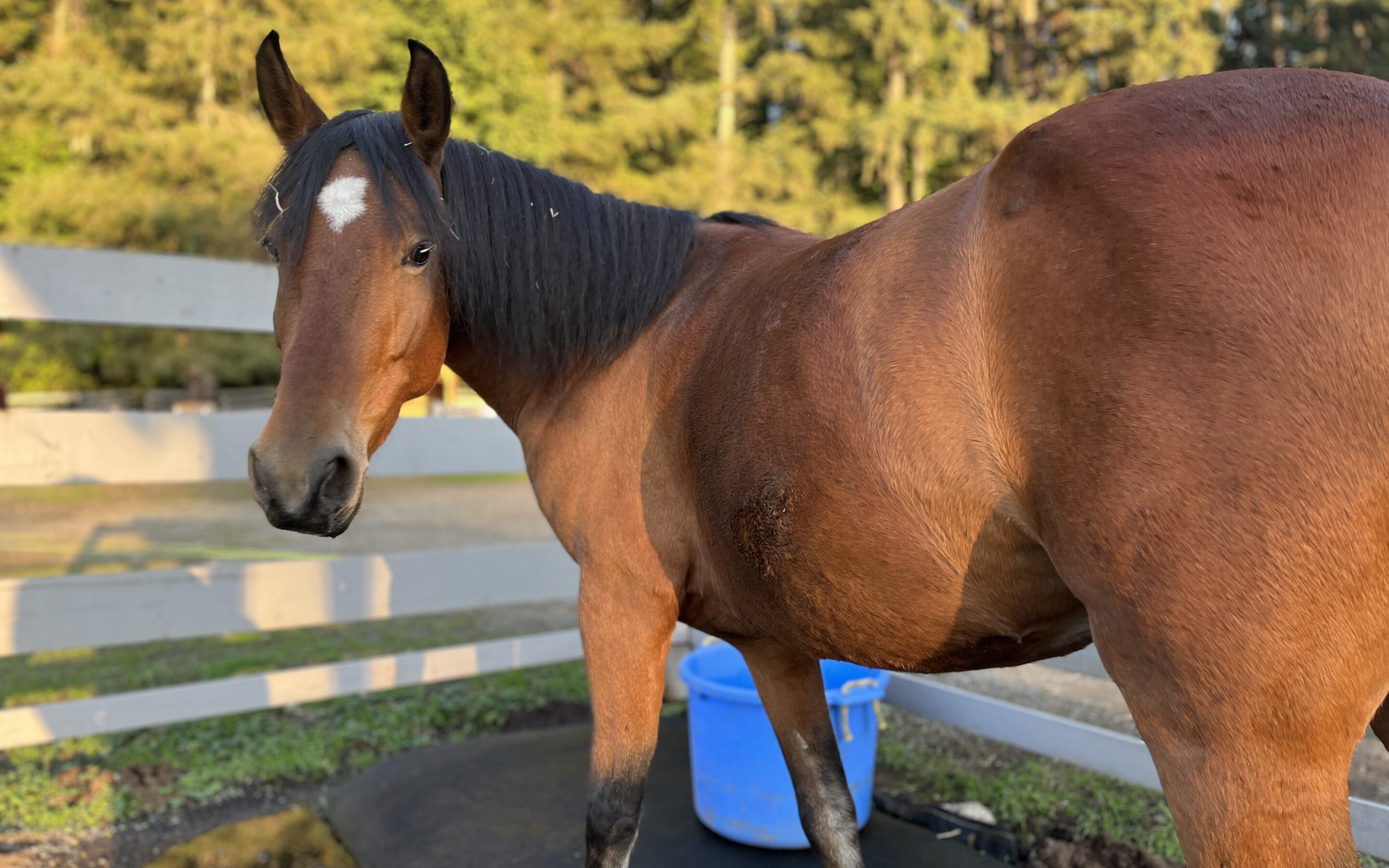
Barbie Girl
We went from lush, green meadows to buzzed dry fields in a matter of a few weeks, and soon as the rain and mud approaches, we will seed our fields and lay them to rest until next year. But even after the grass is mostly gone, the fields and lanes stay open a bit longer to allow our horses a separate location to explore and stretch their legs a bit.
Normally when we open Barb’s gate to the lane, she moseys on out on her own time, scrounging around the fenceline for bits of dropped hay or tufts of grass. But one morning, Barb took full advantage of this little bit of extra space when it was made available to her. She literally kicked up her heels at the opportunity to run a little relay with herself, and spent a good few minutes sprinting back and forth, kicking and bucking and running amok.
While we try to discourage any bouts of intense running, especially in small spaces, we monitored Barb as she cavorted around, and made a note to get her into a round pen ASAP for a bit of endless (and safe!) fun.
Because of copyright reasons and all that, I can’t technically make the video I want, but please imagine that the above video is accompanied by the song Speed Drive by Charli XCX from the Barbie soundtrack. Perfectly fitting considering her name is, after all, Barbie.
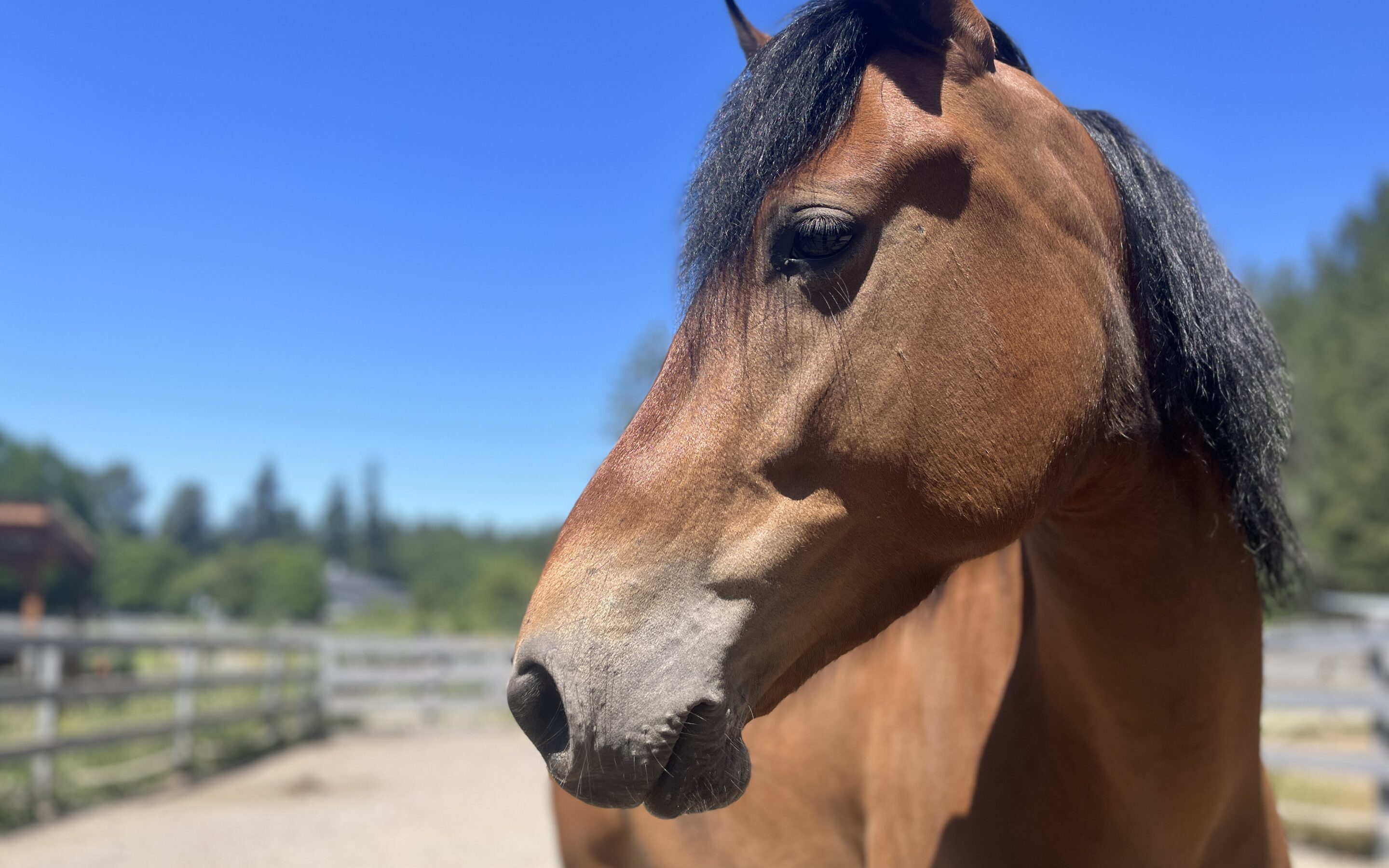
Barb’s Recent Daze
Oh little barb! What have you been up to? Well, for starters, she was turned out with a herd again — do you hear that sigh of relief? Finally, she said. Back in her old stomping grounds, living with other mares 24/7. Getting into trouble, of course. We have to watch Barb a little closer than some. We hear some squealing coming from the direction of the park and prick our ears, waiting for the thunk of a kick landing. But she did well out there, avoided major accidents, made some friends.
Then, a semi-tragedy struck: it looked as though her old injury was flaring up again. If you recall, she crawled under a fence last year and twisted up her hind end something pretty gnarly. One afternoon, we noticed that Barb was looking a lot like she had that first day after her injury — lethargic, kind of humped-up in the back, almost colicky. We called and had the vet out to check her out, and he felt that she had somehow tweaked her back again, and that the best course of action would be to restrict movement. So Barb was plucked from her group once again for a period of stall rest, followed by a restricted turnout space. Bwa bwaaaaa.
But for such a young horse, Barb does surprisingly well on stall rest. She has, unfortunately, had some experience with it, but it means she doesn’t protest very much at all when she has to stay inside. And even in her rehab paddock, separated from her friends once again, she doesn’t have many complaints. Some, yes, especially in the early days. But she has been doing very well being quiet, physically at least.
The good news is, whatever she did this time was nowhere near as bad or injurious as last time. She popped right back out of it, and has begun her rehab process back into regular work.
Let’s rewind a little bit. Before her injury, Barb was going well under saddle, walk trot lope. Casey A has been working with her, and getting some nice changes under saddle. Despite this, Barb is certainly not a beginner horse. She has some ‘zip’ that might intimidate a more cautious rider, so her ideal riding partner will be someone with the confidence needed to redirect her life. But despite her energy, she is not spooky — she just has a sensitive gas pedal. Right before she hurt herself, Barb had gone out on a ride around the property (and with a new rider, too!) and did very well. Likely with a few more miles under her cinch, she’ll make a great little trail horse.
On the ground Casey has been getting good changes with her as well. She can certainly be opinionated and rather pushy, but she has been doing a lot better being respectful at the end of a line when being led.
She will need a little bit of time to get her restart into full swing, but Barb will hopefully be off to her forever home soon — where we will keep our fingers crossed she will keep herself out of trouble!
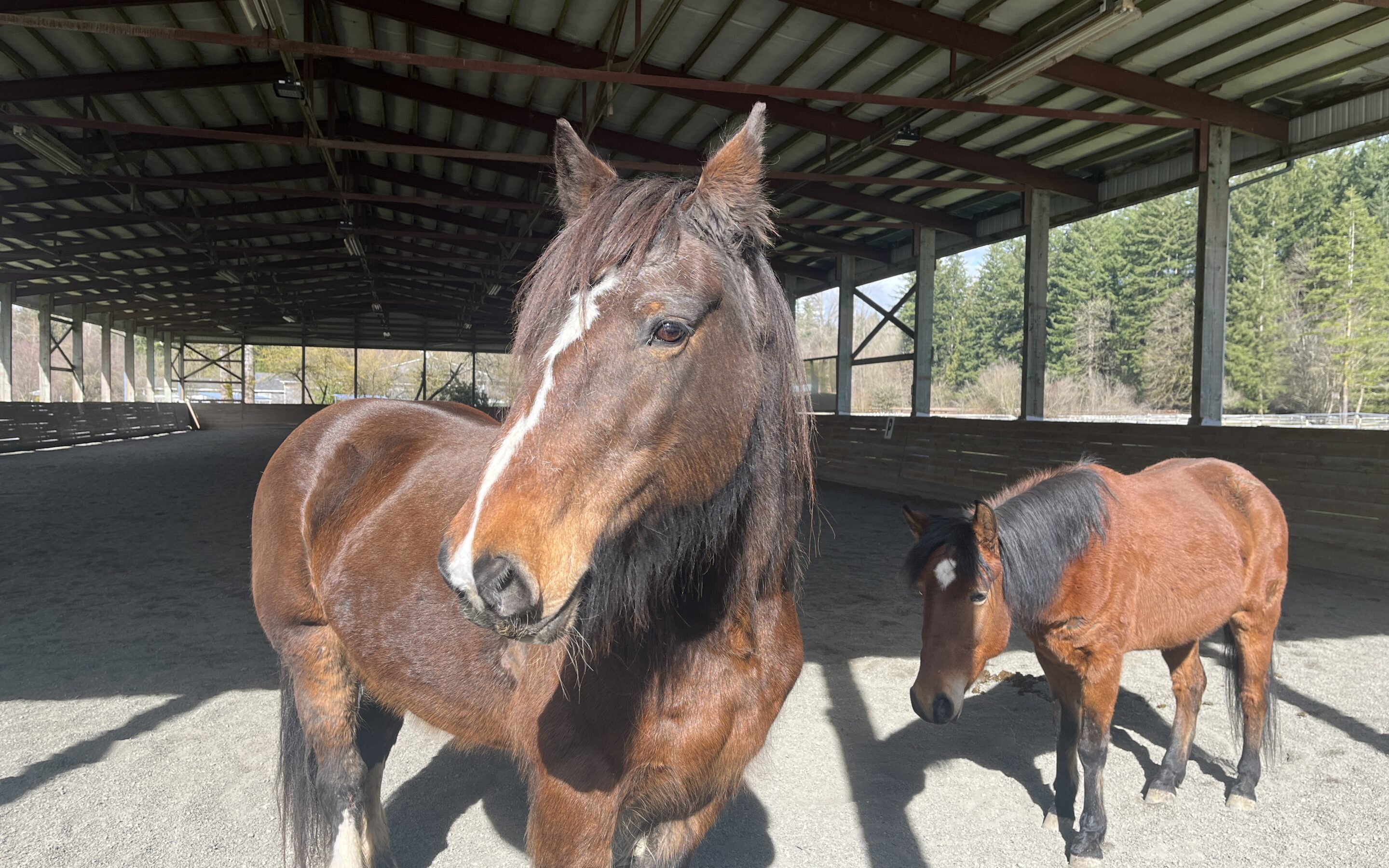
New Friends: Barb & Kelly
Since her stint on stall rest after her houdini moment, Barb has been occupying a one bedroom paddock. If her escapades don’t allude to it, I will tell you directly that Barb is a playful and mischievous creature. If she were written into a novel, the genre would most certainly be adventure, and she would be the main character who trouble cannot help but find. But the one thing currently missing from Barb’s story is a sidekick.
As far as interpersonal relationships go, Barb has not historically been everyone’s cup of tea. She can play a bit rough at times, and does not always know when to call it quits. Her friend Jill – who has since found her forever home – was Barb’s second pea in her pod, but even their close relationship had its ups and downs, requiring stints of separation akin to breaking up a bar fight. Ultimately, Barb is a tough cookie, in every sense of the term – mostly sweet, but liable to break a tooth if you’re not careful.
All this to say, Barb has been overdue for a friend. It has become a kind of Goldilocks scenario at this point, trying to find the perfect place to slot Barb in. This herd already too big, this mare too aggressive. Finding the ‘just right’ is easier said than done.
And then Kelly arrived at SAFE. Sweet Kelly, a gentle giant of a mare who had plenty of experience living in a varied and diverse herd environment. Kelly, who we had no reason to believe would be anything but mellow with mostly anyone we put her out with. Kelly, who we felt could be Barb’s ‘just right.’
Introducing the pair on halter ropes was primarily uneventful. Barb can come in a bit hot, but paired with Kelly’s aloof nature, there was no big drama in their initial interaction. If anything, Kelly just seemed rather bored with Barb, who was practically foaming at the mouth for a chance to have a new buddy. Once we let them loose together, we waited with bated breath to see what would happen. Would Barb drive Kelly crazy, wanting to play? Would Kelly in turn show Barb the underside of one of her dinner-plate hooves? Would both girls make it out alive? (Ok, that last one was dramatic — we weren’t actually thinking along those lines.) But we were pleasantly surprised when.. Well, nothing really happened. Kelly gave Barb the lukewarm shoulder, and Barb quickly fell into her best impression of Kelly’s little shadow, following the bigger mare around at a distance that Kelly OK’d.
It has been a good exercise for Barb, being out with a mare who doesn’t necessarily want to play, but who isn’t going to get either of them into too much trouble. And while Kelly isn’t the most expressive of horses, she doesn’t seem to dislike the company. Since their initial meeting, the pair exist in a nice harmony of tandem walks and the occasional nap together – not too close, not too far. It has been wonderful to watch a new friendship blossom, and to witness two single ladies come together.
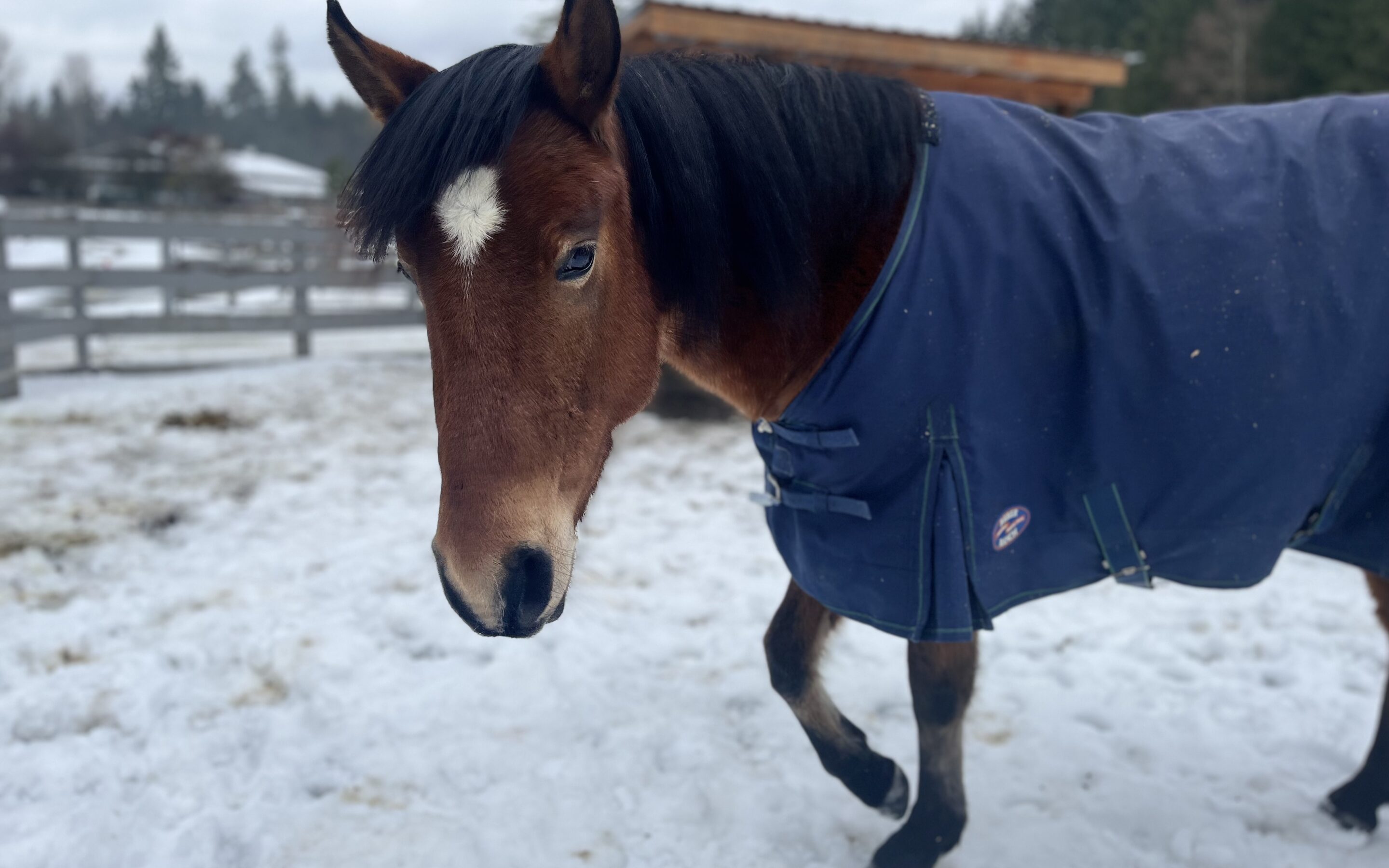
Barb, in Summary
Here are some things about Barb, otherwise known as:
Barbie, when she is behaving like the doll –
Barbra, with a stern intonation, i.e., when she’s exercising her right to be impatient –
Bobblehead, when she’s silly (which is quite often, being newly four and all) –
Barbarella, when, well, whenever. We do really like nicknames here at SAFE.
No matter what you call her, this little mare is looking to meet potential adopters. I’m putting together her personal ad, since she can’t write very well, but rest assured, we have watched Barb grow up here at SAFE, and can tell you what she’s looking for in an ideal home.
I touched on her size already. At 13.3 hands, physically Barb is pony-sized (but the very definition of big things coming in small packages). Despite her stature, her personality bursts forth, the nesting dolls within her containing enough character to fill at least three tall warmbloods, and that’s being modest. So while she is small, she is mighty. At this point in her education, Barb still needs direction in the form of an advanced rider. Child-sized as she might be, it will need to be the skilled hand of an experienced adult to keep Barb on course during this stage of her life.
She is also young. Freshly four, the miles Barb already has on her will be overshadowed by those yet to come in the course of her life. Her start here at SAFE has put her on the path for success, but she will need ongoing guidance to help her stay the course. But what that also means is Barb will be, for the right person, a great project. She has a solid outline, with lots of room for added detail.
Barb is very good at finding ways to entertain herself, but would prefer a little help. Romping and playing, preferably with a friend or two, are just a couple of Barb’s certified skills. As far as four-legged friends go, Barb will benefit from those who set firm boundaries and do not let her mischievousness get out of hoof. Barb is ready to climb to the top of the monkey bars and announce herself as queen of the playground, and therefore needs a resolute leader to shake their head and kindly tell her to get down from there before she hurts herself.
Though looks aren’t everything, Barb is certainly not lacking in that department. There really is just something about a bay horse. Her black stockings are unmarred by white, aside from the wispy white feathers that grow from the back of her cannon bones. Her star resembles the outline of some fantasy country, perhaps one where little bay ponies rule the roost. And her hair — thick and luscious, this girl has hair for days, perfect if you’re the type who enjoys trying out new braid styles.
Under that enviable forelock is a very smart brain. Barb wants to see it all, smell it all, experience it all, and is looking for a human who can, safely and with discernment, show her the world. She is one special little mare, and one who will certainly make someone a complex and engaging lifelong partner.
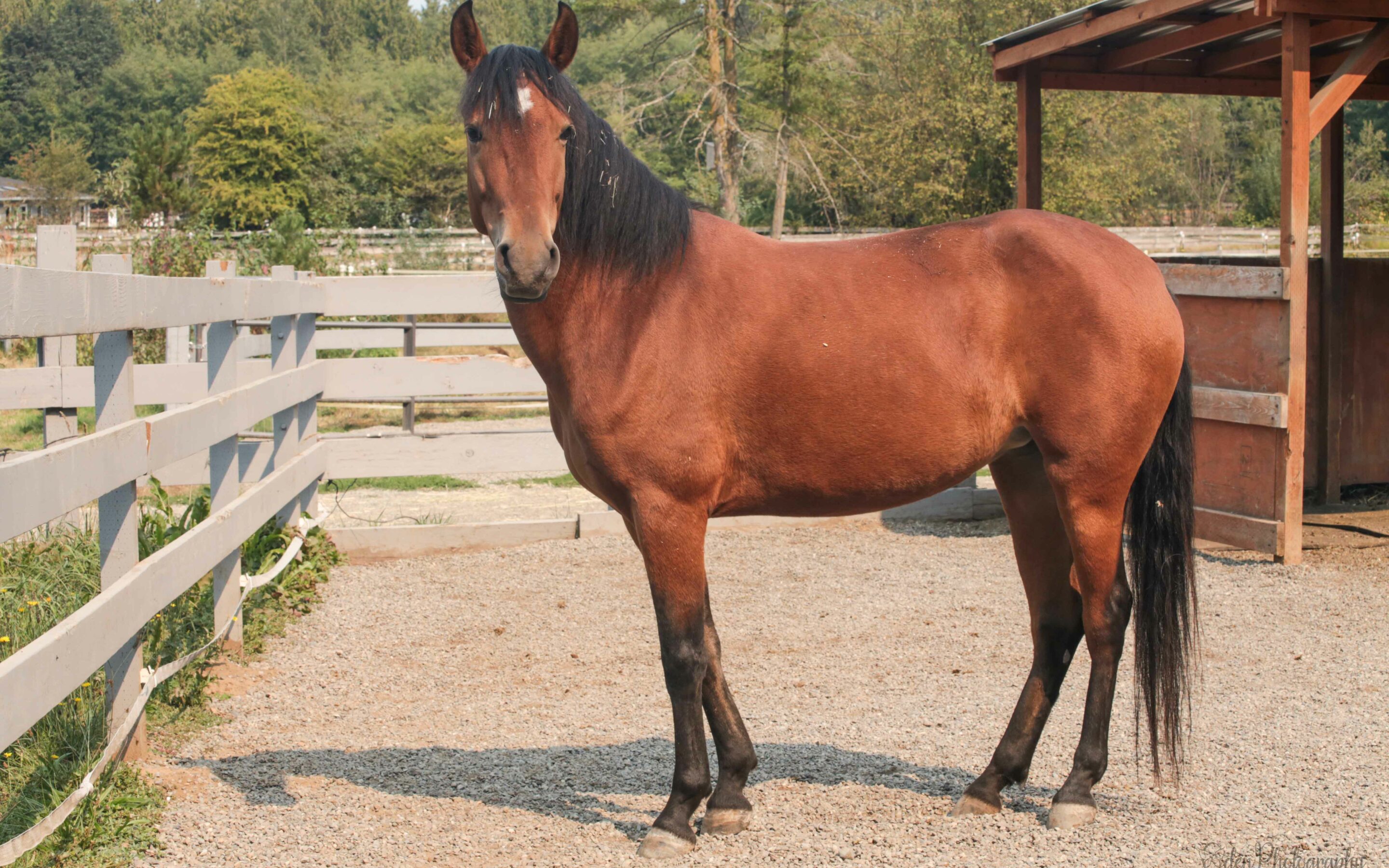
Barb, Out of the Woods
Have you seen Alfred Hitchcock’s ‘Rear Window?’ Poor Jimmy Stewart, laid up in his apartment with a broken leg, unraveling a murder via a pair of binoculars. In the horse-remake, Barb might play Mr. Stewart (the jury is still out on Grace Kelley’s stand-in) given that she has spent the entire summer holed up on stall rest, hanging her head out the window, observant.
Luckily, there have been no bodies buried in the garden, and even luckier that Barb is slated to make a full recovery. Back when it first happened, we had our concerns about her future. To wedge yourself beneath a fence is no joke, and it was difficult to gauge the extent of Barb’s injury based on its location.
We rested Barb, who coped with her time in isolation very well. I’m knocking on wood while I’m typing this, but we have had great luck with all the horses who have been assigned stall rest – even the youngest and most energetic of our flock have done remarkably well sitting inside for weeks at a time. Barb did not threaten to knock the walls down at any point during her tenure in a stall, nor did she lose her usual verve. Perhaps it felt good to rest.
Dr. Rathbone attended her twice – once for a chiropractic adjustment, and the next for acupuncture. We spoke with our vets at Rainland regarding a rehab plan, and after several weeks of rest, we started Barb on a slow path towards restoration.
It usually begins with hand-walking for short periods, increasing in time over weeks. Adding the weight of a saddle and rider is important for conditioning, and we slowly built Barb up to this point. Short bursts of trot were added, and eventually, the lope. All the while we were checking in with our vets, monitoring to ensure Barb continued on a forward track.
Since her rehabbing began at the beginning of August, Barb has only been improving. At the 6‑week mark, she was allowed back outside in a small rehab lot, and while we all expected her return to the great outdoors to be marked by much fanfare (running and bucking), she simply walked over to her hay box, calm, cool and collected. She had a re-check at the beginning of September, where she got the all-clear to continue upping her regime. So for the last month, she’s been back in the saddle, almost like nothing happened at all (the shorter sessions would betray this as truth), but our little Barb is nearing the end of her path towards returning to normalcy again, one that will hopefully culminate in her finding a forever home.
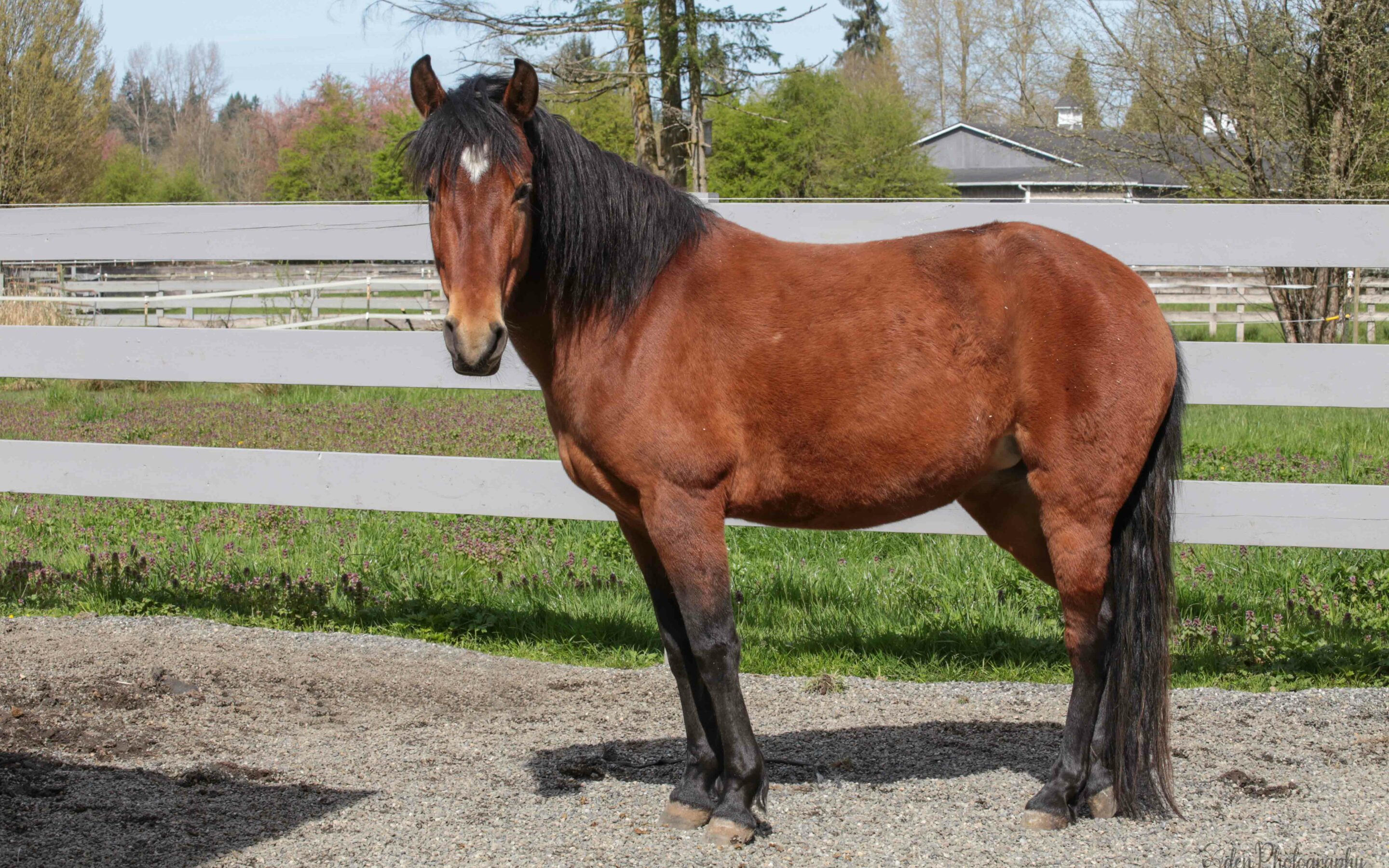
Barb, the Houdini
If you know horses, you know their proclivity for finding themselves in less than ideal situations. Barb, a mare too smart for her own good, recently got herself into one such scrape when she decided to liberate herself from her paddock by tunneling beneath her fence. It sounds quite impossible a feat, but the acrobatic feats horses are capable of really know no bounds. Unfortunately for Barb, her athletic prowess was not well rewarded — when we found her outside her paddock, munching away on grass, her back was hunched and she was behaving lethargically, a word that one would not typically use for Barb.
Worried, we called the vet. Dr. Lewis was quickly on the scene, where she had Barb move out a little — her range of motion was very limited, she was dragging her right hind at the trot, and generally reluctant to move. But there were no visible injuries, and no palpable heat or swelling present. Watching her move, Dr. Lewis considered the possibility that Barb was tying up, or experiencing a gas colic. She drew blood, and sedated Barb in order to intubate, where she gave Barb fluids and tried to get some of the grass up. Not a ton of grass came up, which was a good sign — if she were very gassy, more would have been expelled. Dr. Lewis also gave Barb some mineral oil to help settle any gas and cut some of the sugars from the grass. Then, it was rest and fluids for Barb as we waited on the bloodwork results to come in.
When they did, it was revealed she was not tying up, so there remained a mystery as to what was really going on. She remained quite lame, still unwilling to weight her hind, almost ‘skipping’ at the trot. At this update, Dr. Lewis had us start her on some bute.
At her next evaluation a day or so later, Dr. Lewis again watched her move out, palpated her leg, and tried to determine where the issue lay. Ultimately, she landed on it being a potential SI injury, and recommended continued stall rest and a course of muscle relaxers to keep her comfortable.
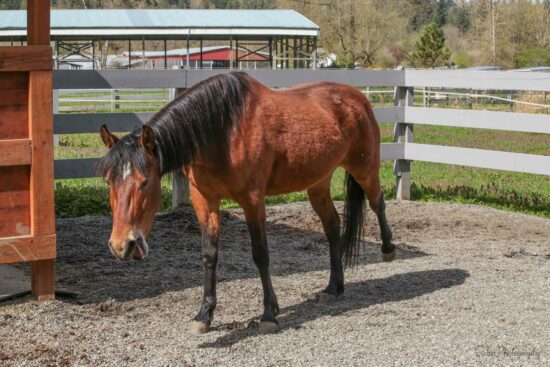
We can’t wait to get Barb back to feeling herself, yoga stretches and all
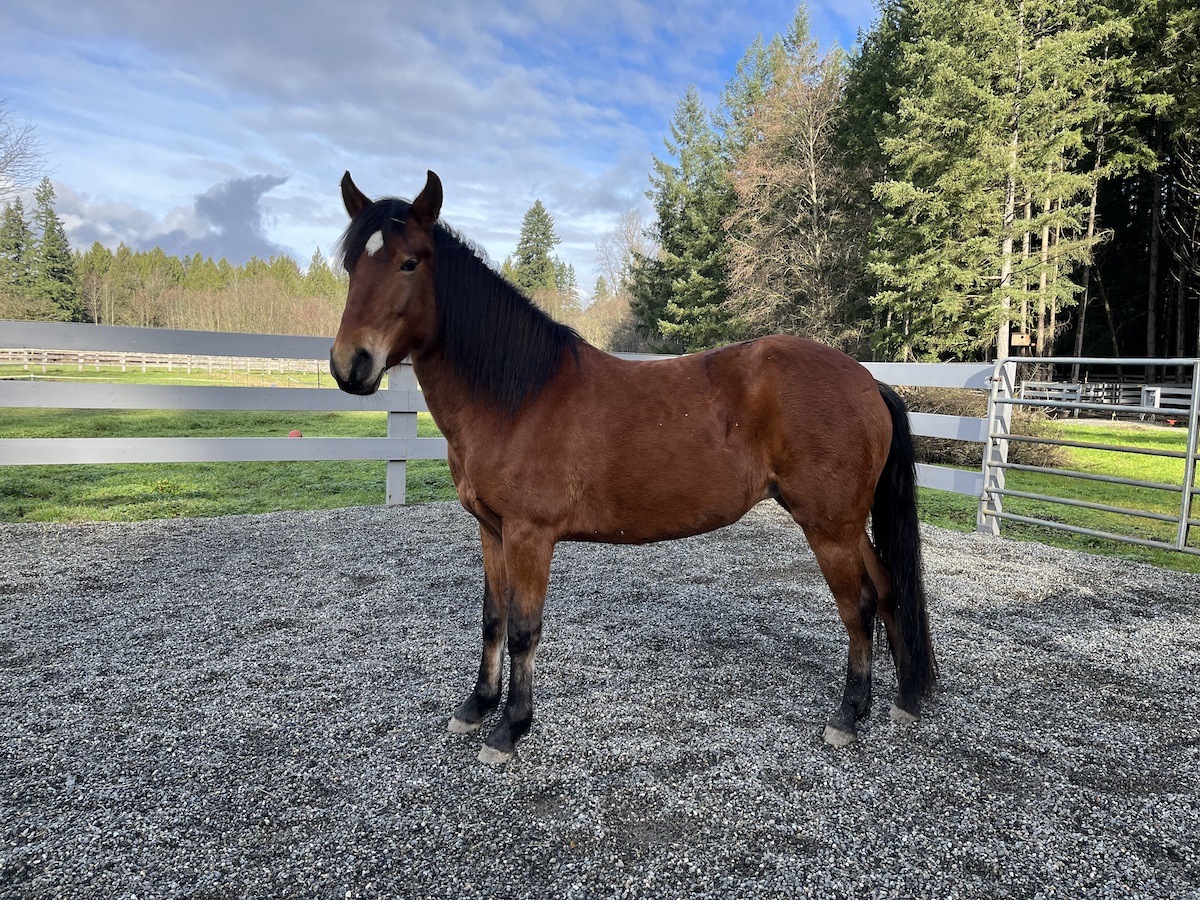
Barb Needs a Knowledgeable Partner
Barb has a very strong sense of justice, so if you fail to release her immediately when she does the right thing, or add pressure that’s not meaningful, she’ll resent your poor timing. When you time up correctly and have good consistency of your feel and movements, Barb feels supported and can be the softest mare with a ton of effort to do the correct thing. Barb is comfortable being roped off of and would probably love to try her hand at sorting cows. For now, she’ll focus on herding the geese around SAFE’s property.
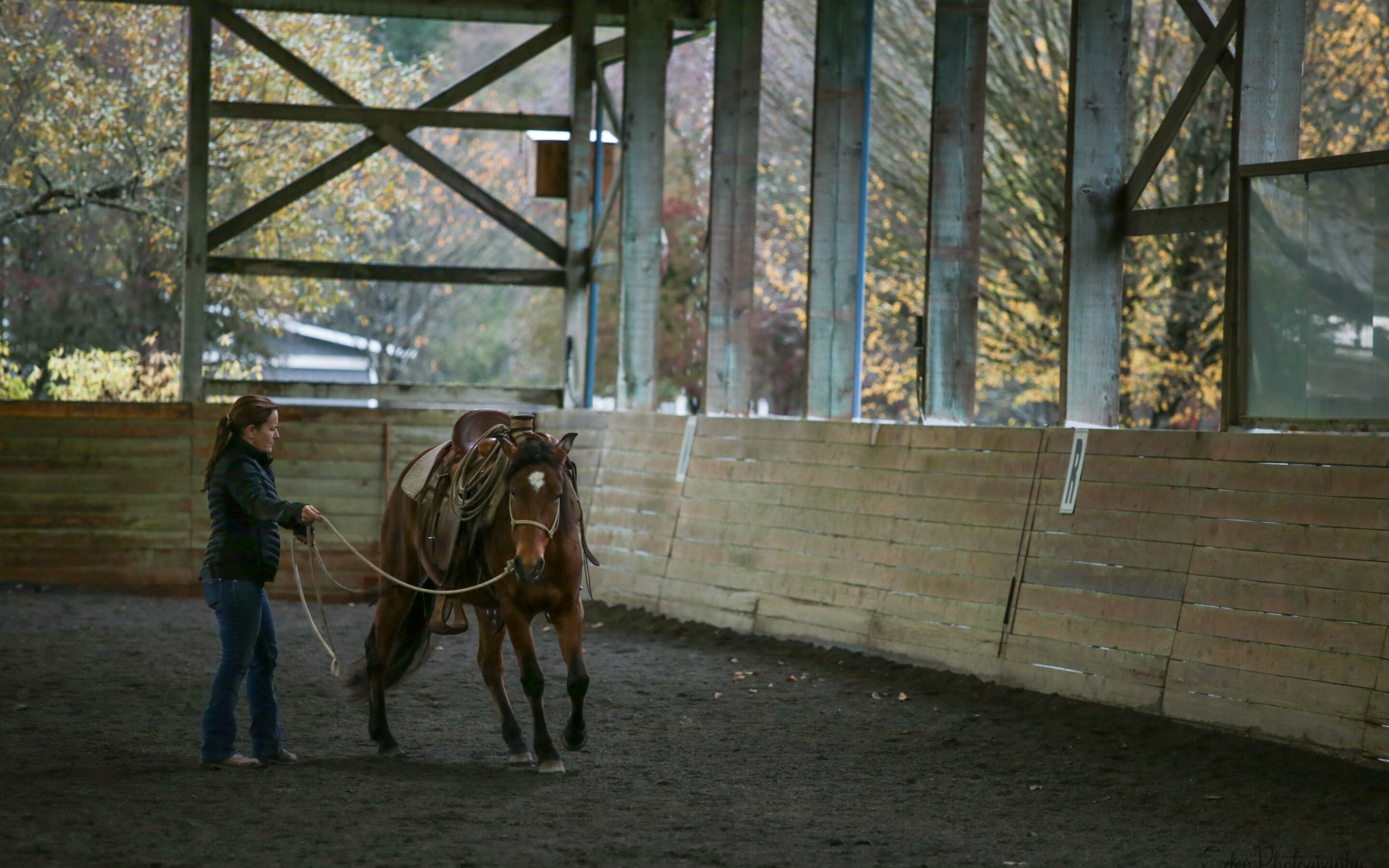
Barb at the Joel Conner Clinic
Candi, a volunteer rider, recently worked with Barb in the Groundwork Clinic in November. Here is what she had to say about her.
“Barb is not a Barbie Doll! Barb might be small, but she is smart and strong. She may be a ranch horse in the making with her quick moves. Barb and I worked together for the first time in the groundwork session of the November Joel Conner clinic. It would be an understatement to say we learned something from each other. We learned A LOT!
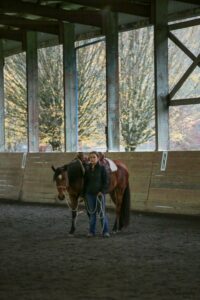 Beyond a doubt, Barb has an opinion. Out of all the horses I have done groundwork with she is by far the most difficult. Challenge accepted. Going back to the very basics of unified circles with a soft feel yielding the hindquarters made all the difference in the world. Over the course of three days, we worked on backing up with a soft feel. By the end of the clinic, I did not even need to put my hand on the base of the halter to back her up. When I asked her she could feel me and backed up on her own. We also worked on what I like to call the “front quarters dance” up and down the arena. This is a great exercise for changing eyes. We were not the best dance partners to begin with. I needed to move her feet out of my space to create rhythm. By the end of the clinic, we were not stepping on each other’s toes.
Beyond a doubt, Barb has an opinion. Out of all the horses I have done groundwork with she is by far the most difficult. Challenge accepted. Going back to the very basics of unified circles with a soft feel yielding the hindquarters made all the difference in the world. Over the course of three days, we worked on backing up with a soft feel. By the end of the clinic, I did not even need to put my hand on the base of the halter to back her up. When I asked her she could feel me and backed up on her own. We also worked on what I like to call the “front quarters dance” up and down the arena. This is a great exercise for changing eyes. We were not the best dance partners to begin with. I needed to move her feet out of my space to create rhythm. By the end of the clinic, we were not stepping on each other’s toes.
Barb is a spitfire and willing to work. She will be a good partner for someone who can ensure her success through continued horsemanship training. She needs a solid partner who will set boundaries yet reward her for her accomplishments. Giddy up and gather the cows little girl!”
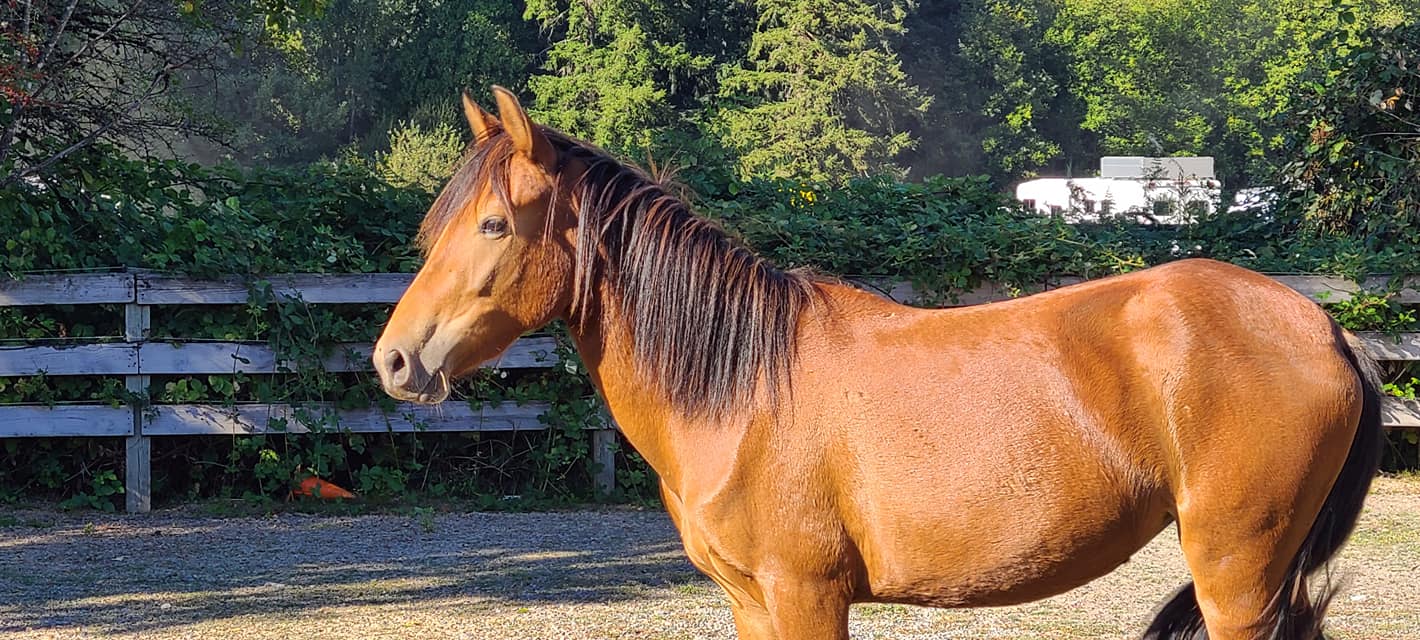
New Adventures for Barb
An update on Barb’s training progress from Kaya:
Barb has been gaining new experiences on the ground and in the saddle. We took a hand walk out on the trails and have been ground working on different parts of the property. While Barb initially has many opinions and doesn’t believe me that she can rely on me to look out for her, we eventually get to a place where she understands that she doesn’t have to be on guard all the time. Barb doesn’t surrender her leadership easily, but when she finally gets with me and settles in, she does huge releases of blowing air, sighing and relaxing and it’s very rewarding. Every time we work together, it takes less and less time for Barb to realize that she’s better off going with me rather than trying to fend for herself.
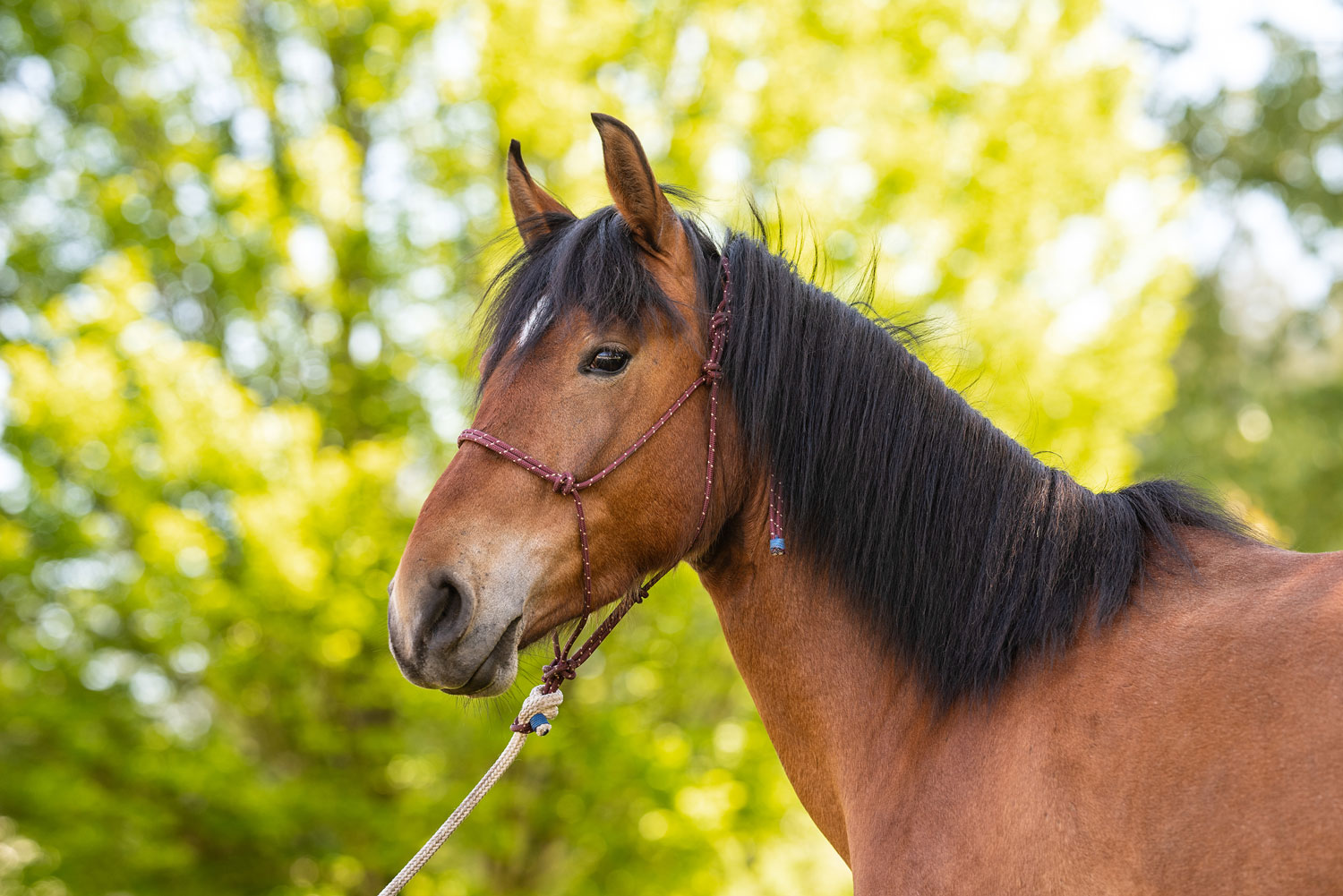
Barb is Ready for Adoption!
As Barb has matured, she’s started to look somewhat different from the other Fall City horses. She has longer legs and a more refined look, but remains a bit roly-poly. Kaya has been working with Barb to help her stay focused in larger spaces so that she can be ridden outside the round pen. Barb did great on a recent trail ride through the park adjacent to SAFE. Barb has had 5 months of light riding and is ready to be adopted. She is an athletic mare and seems to enjoy the work when under saddle. Her ideal adopter will be an advanced rider with experience training green horses. We believe Barb will be a fun ride for the right adopter.
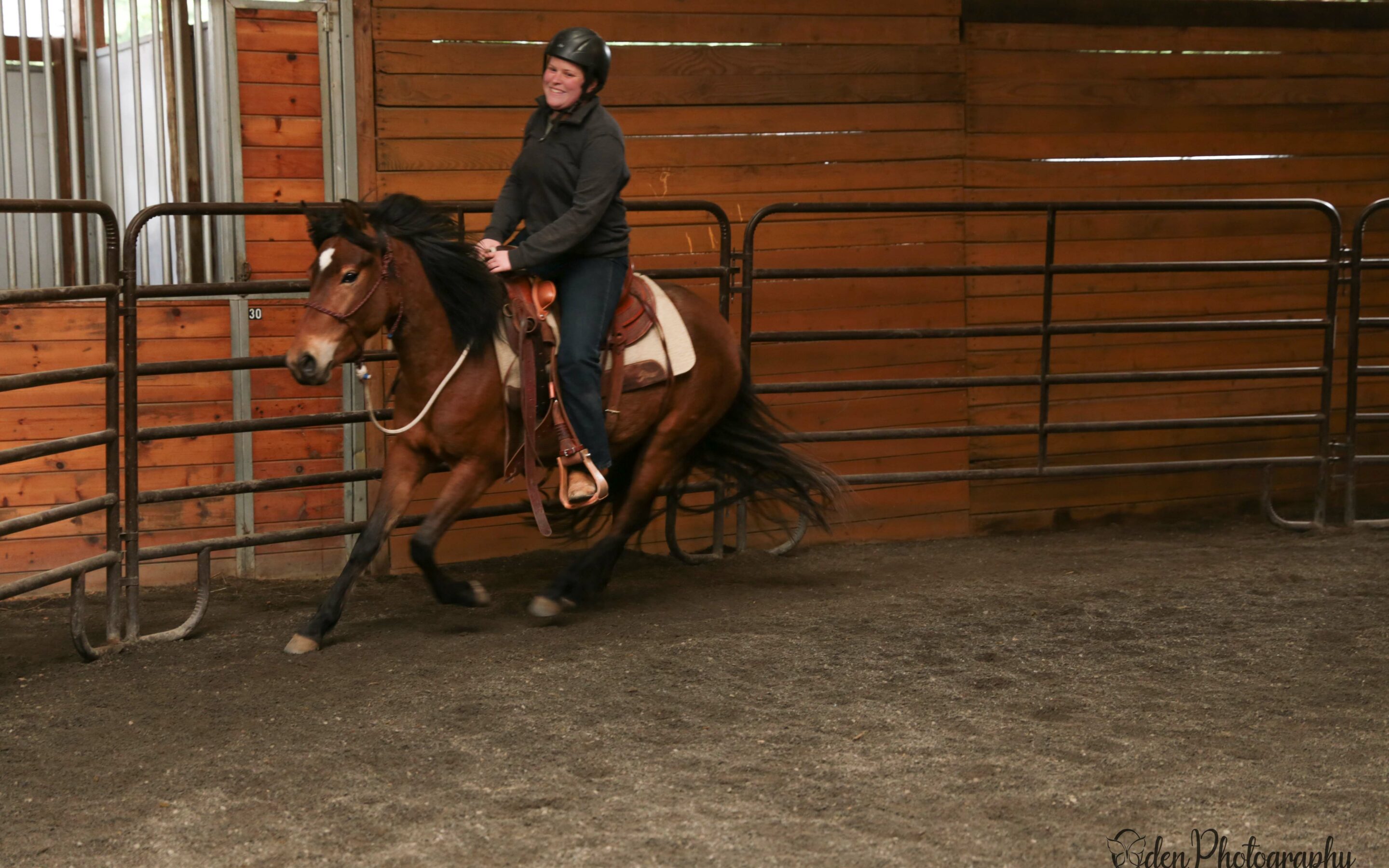
Barb is a Riding Horse!
Kaya has been working with Barb since she arrived at SAFE. Here is what Kaya had to say about her:
“Barb is turning out to be an all star riding horse! This sweet, charismatic, opinionated, intellegent pony keeps surprising me every ride. Barb was one of the most difficult groundwork horses I had ever worked with, but she has really turned that all around. She is now riding well on a loose rein, moving through all transitions off of a feel and is starting to get better about steering using legs instead of relying on reins. Barb carries a soft feel beautifully at the walk and trot and has even started working on some leg yields! The next steps for Barb will be working more on a soft feel in the canter and through transitions. She will also start working with other volunteer riders soon so that she can get used to other people’s feel and seat. I’m so proud of this fun little lady and can’t wait to see what the future holds for her!”
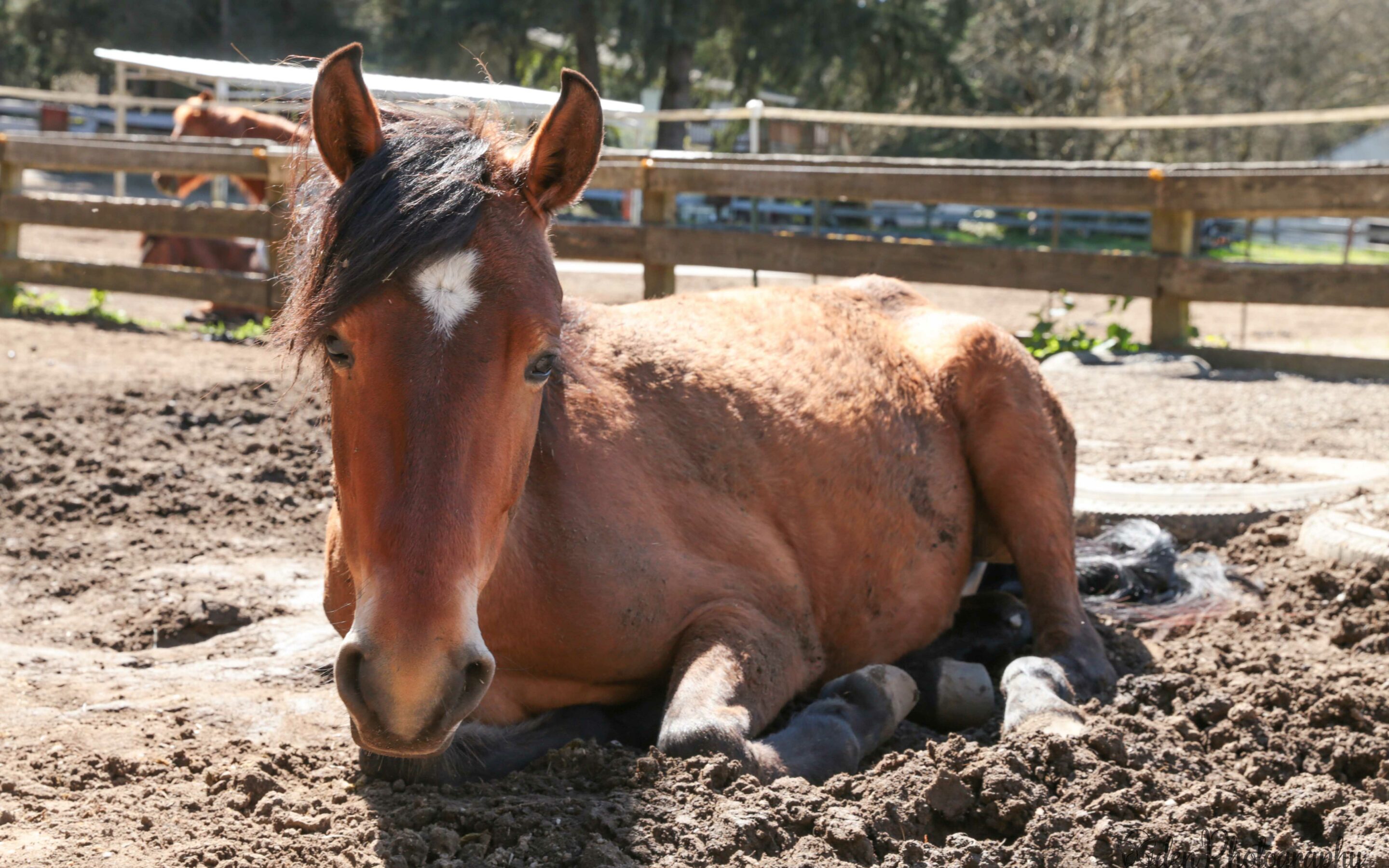
Barb Has Opinions
Barb had a few weeks off from work after having been ridden for about a month. She is just three years old, so it’s age-appropriate for her to have a break from being ridden. Barb is a champ at accepting a fly mask. Personality-wise, Barb is opinionated and can become petulant when told “No”. She appears to be moving up in status in the filly herd and taking over the lead filly status from Pippi. Barb’s paddock buddies include Pippi, Nova, Jill, Rae, and Pearl.
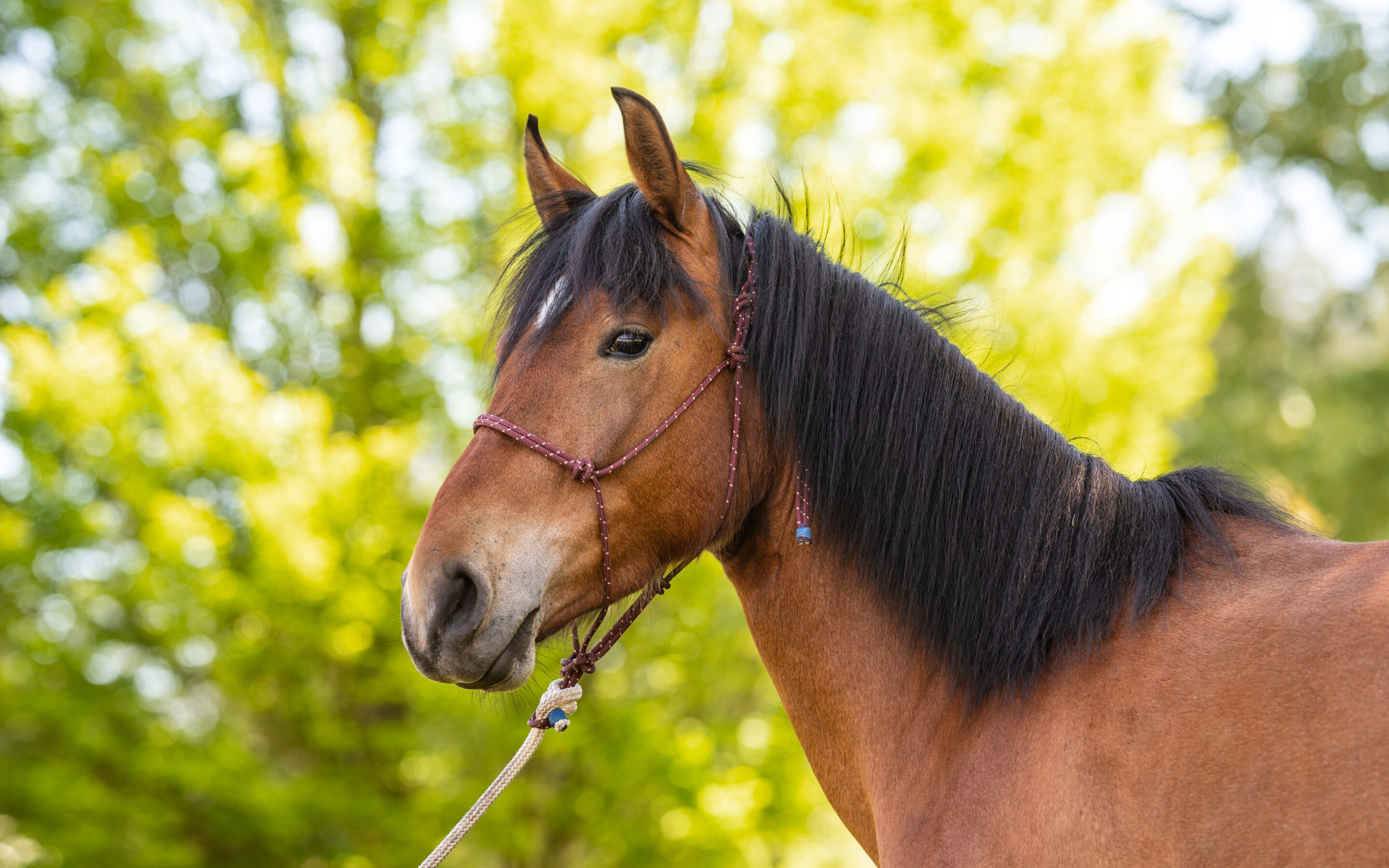
The Limelight Pet Project: George, Barb and Jill
George, Barb and Jill were recently featured by the Limelight Pet Project! Limelight’s mission is to shine a light on harder to adopt pets and tell the stories of the people helping them. These three horses were all started under saddle recently and are very young. They will all need to go to homes with very advanced riders who have experience with green horses.
We know there are homes out there for them, we just have to find them the right person. We’re grateful to the Limelight Pet Project for helping to illuminate their stories. Check out the two videos below!
Here is the full interview.
This video is a short highlight of the three horses at only a minute and a half.
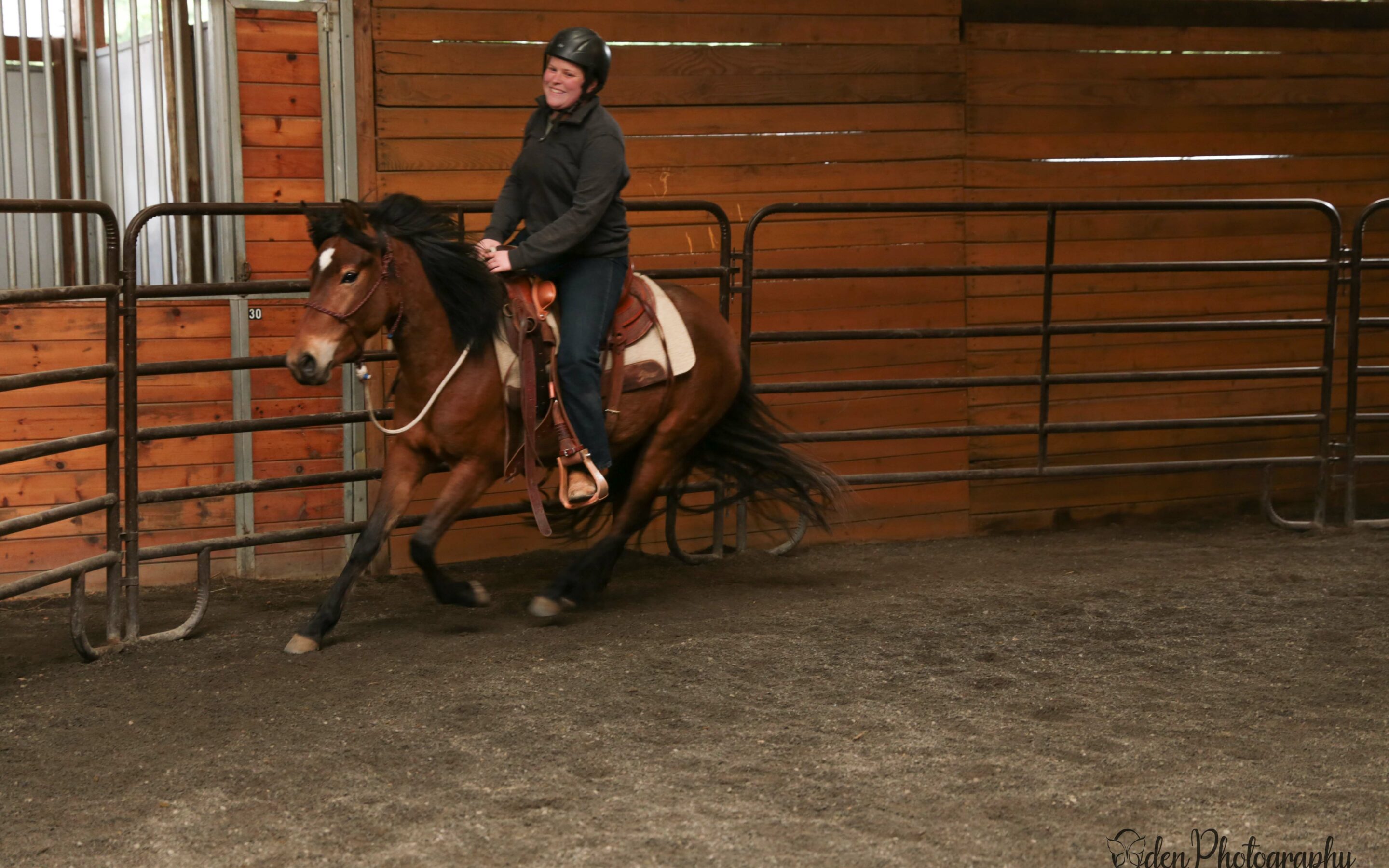
Barb Started as a Riding Horse
Barb has become Kaya’s favorite horse to work with. She was ridden for the first time at the Joel Connor Clinic a few weeks ago. Then Kaya got on and has been working on riding her ever since. Barb is a very opinionated pony, but seems to enjoy the work. She is really athletic, but needs to work on balance, so that she can show her athleticism. Kaya has recently started working on bridling with Barb. She appears to enjoy having something she is allowed to bite!
Barb gets to enjoy her off time with a herd of six other ladies. You can often see them all taking naps in the sun, all huddled together.
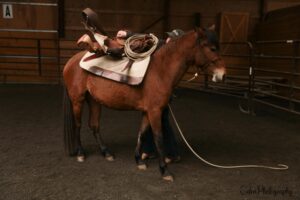
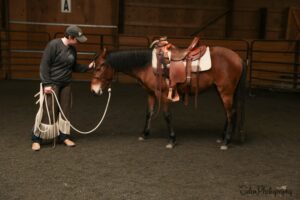
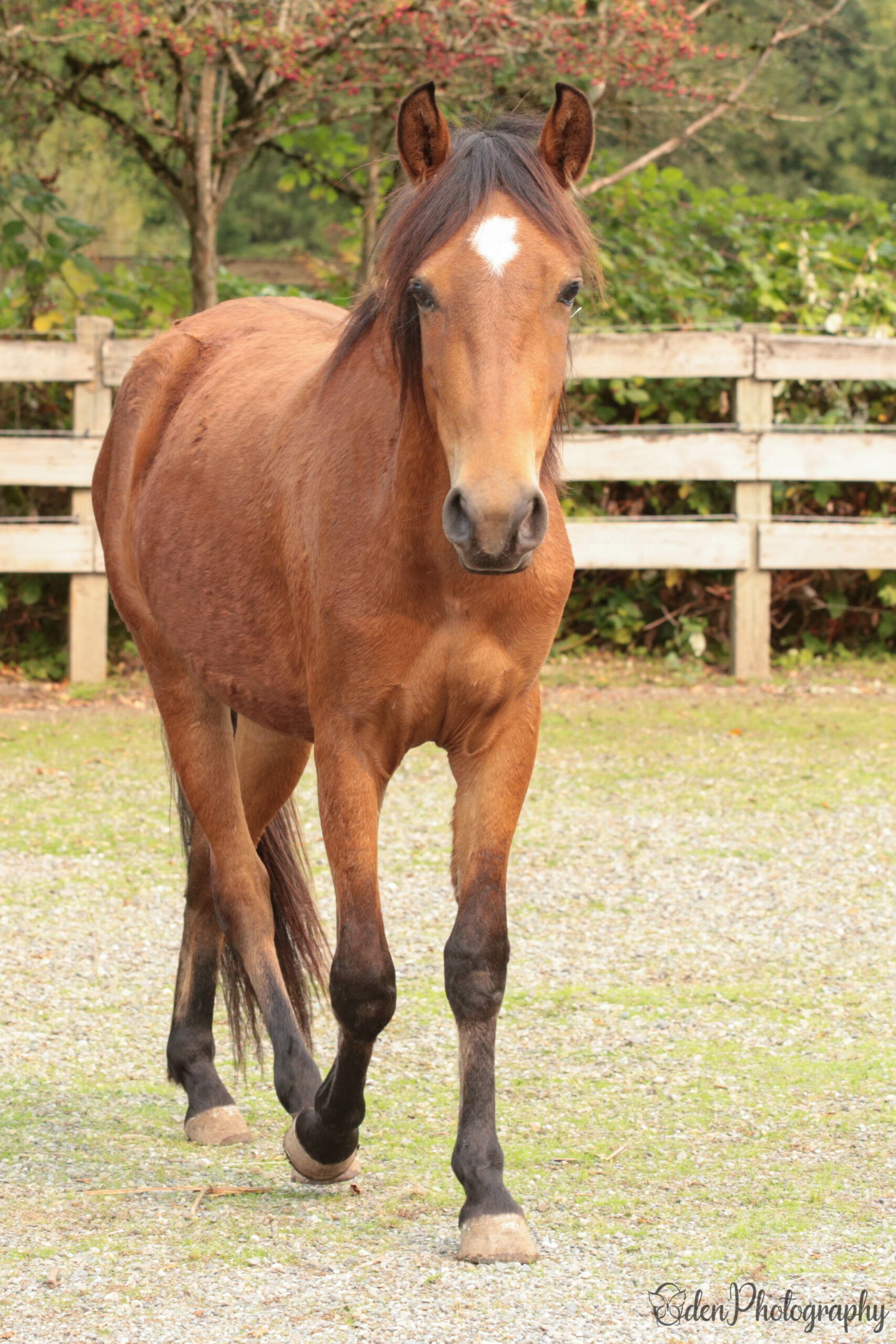
Joel Conner Clinic Report: Barb
Here’s a clinic report from Sarah V who worked with Barb, one of the Fall City 40 horses:
I’d never worked with Barb before Thursday of the clinic, but was really excited to have the chance. I was onsite in Fall City in July of 2019 when we were trying to separate some of the mares and foals from the 9 studs they were sharing a pasture with. The unhandled herd spooked and started racing around and we watched in horror as tiny Barb slammed into and over a barbed wire fence, jumped up, and took off across a neighboring property. It took quite some time to track her down and rejoin her with the herd, but luckily all she suffered were some minor scrapes.
Working with her today, you’d have no idea that she was once so terrified of humans that she’d run into a barbed wire fence to escape them. This adorable filly was saddled by Joel for the first time at the November clinic and all of the groundwork done by volunteers in the horsemanship program leading up to the clinic made that milestone relatively uneventful.
Joel noted that Barb is a bit “hard” and braced in her hind, but I’m also still working on honing my own feel and timing to better “offer a good deal, pick up the pressure until I get a change, and then release.” Barb was starting to get a sour expression because I was staying in my ask too long, neither increasing the pressure nor offering a release. Because Barb is young, Joel encouraged me to not “nag” her by continuing to ask with the same level of feel without getting a change. He instead encouraged me to increase the pressure as needed, and make sure I release immediately once she makes a change to reward that try as soon as possible and keep her from getting sour.
She had a tendency to rush from hindquarters to front quarters and crowd the handler some, so we are continuing to work on that. Joel corrected my inclination to want to stop her when she moved forward without direction from me, saying (particularly as a young horse) we want her to be free in her feet and know she can move, so I should instead work with that forward momentum (rather than getting uptight about her making a mistake), and just ask her to do something different.
In my groundwork prior to saddling, Barb was calm and steady with being touched all over with the coils, and relatively unbothered by the flag or moving with the rope around her hind and barrel.
Once she was saddled I repeated the groundwork, and Barb was amazingly great with me noisily tapping the saddle all over with the coils, flagging her, having the rope around her hindquarters, and moving the stirrups all over each side. When I took her halter off and moved her out, she had only a few tiny bucks and offered lots of forward, including a very smooth looking trot and lope. She’s a nice-moving little mare! When moving her out, she would sometimes get in a zone and tune me out, just loping around the round pen, so at those times Joel had me change direction or do something else to help her refocus on me.
Joel gave me some instruction on my extremely limited roping skills and Barb was a champ about letting me inexpertly toss a coil over her back or towards her hind legs while she was trotting around the round pen. The second day, she had a bit of a cinch sore, so we didn’t saddle her, but repeated the groundwork.
On Saturday we worked on bumping her up to the panels (my first time doing this myself), so that she could get used to a person being above her touching her on both sides (which requires changing eyes). It took some time for both of us to figure out (me to experiment with the type/duration/pressure of bumping her in the right way to help her keep searching for the right answer which was to line herself up along the fence), but when we did it was AMAZING. Barb got lots of pets and scratches, and was interested but unworried about me reaching over to move the stirrup on her off-side, tapping the saddle, rubbing her neck on both sides, and waving the flag over and around us.
On the final day of the clinic, the cinch sore was no longer bothering her, so we saddled her again and she did really well. When I tried bumping her up to the panels she positioned herself correctly almost right away and got lots more pets and scratches and we did a bit more with the flag and off-side stirrups. She was alert but relatively relaxed for all of it. If she started to walk off, Joel had me let her, but then bring her back next to me. My homework is to keep working with her to improve her hindquarters, and also to work on the dynamism of my feel and timing of my releases to make her more responsive and free.
I’m so grateful for the opportunity to work with this smart and adorable little mare, especially because it’s challenging me to more finely tune my feel and timing to help her better understand what’s being asked of her and feel capable, respected, and free. I’m really looking forward to continuing to work with this cool little horse and can’t wait to see how she grows!
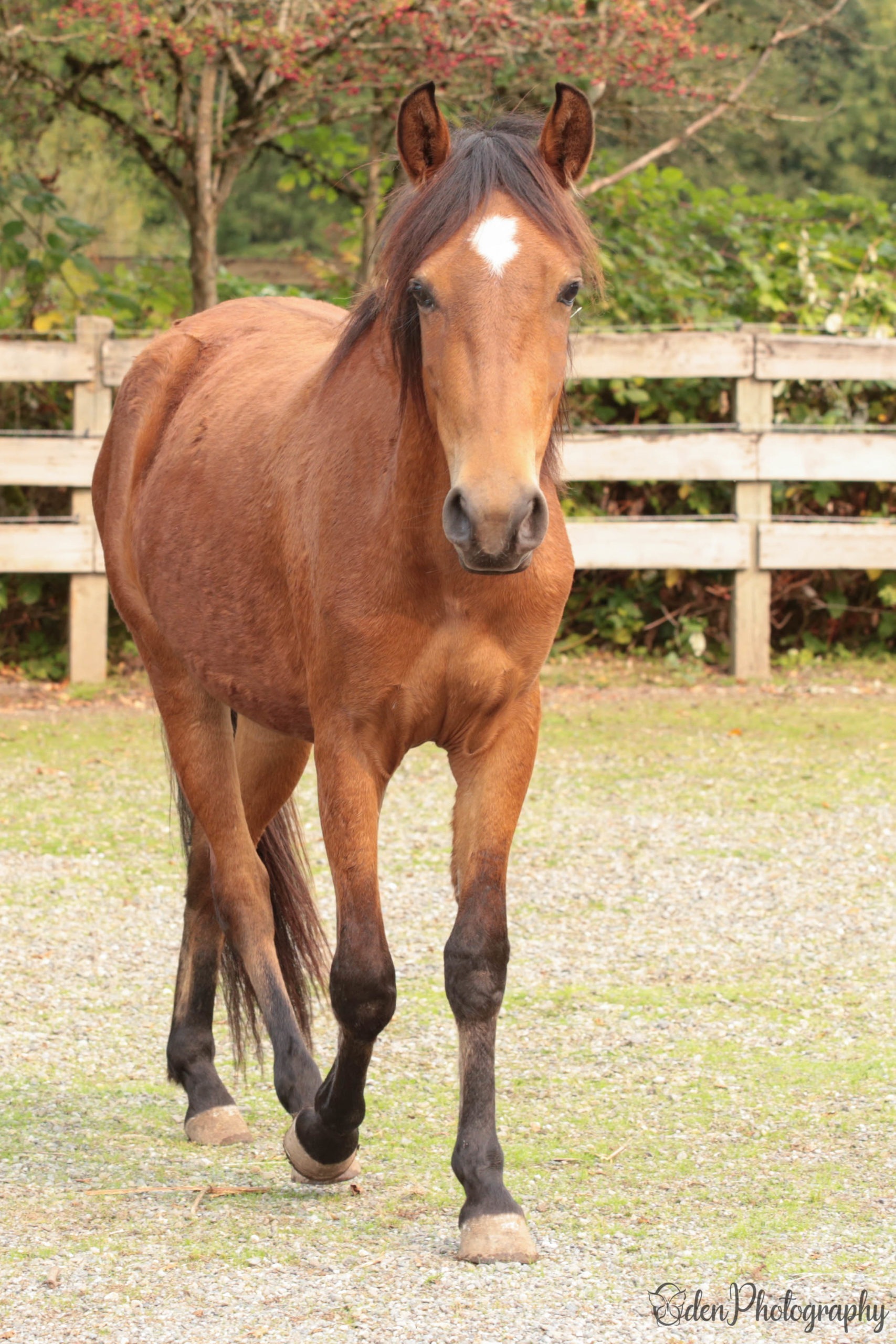
Joel Conner Clinic Report: Barb
by Kaya M.
Sweet Barb is coming along so well with her training! She started the last clinic weekend a little dull and Joel explained that she needed to get her feet a little freer so that she could voice her opinion. We worked a lot on freeing up her feet and changing eyes. We also did a lot of rope work, including roping all four feet and leading off of them. Towards the end of the clinic Barb showed off a little attitude, but in a good way! She was free enough that she wasn’t just merely putting up with the rope around her, she questioned it and expressed her discomfort. This allowed me to show her how she can still move and the rope is not restricting her freedom. We continue working on this point and she is getting more and more accepting of things like the rope around her cinch area and a stirrup on the opposite eye from me. Hopefully she’ll be ready to saddle at the next clinic! Either way, she’s a smart little one and is really fun to work with!
Barb and her Towel
Barb’s taking everything her foster throws at her–even a towel!–with grace.
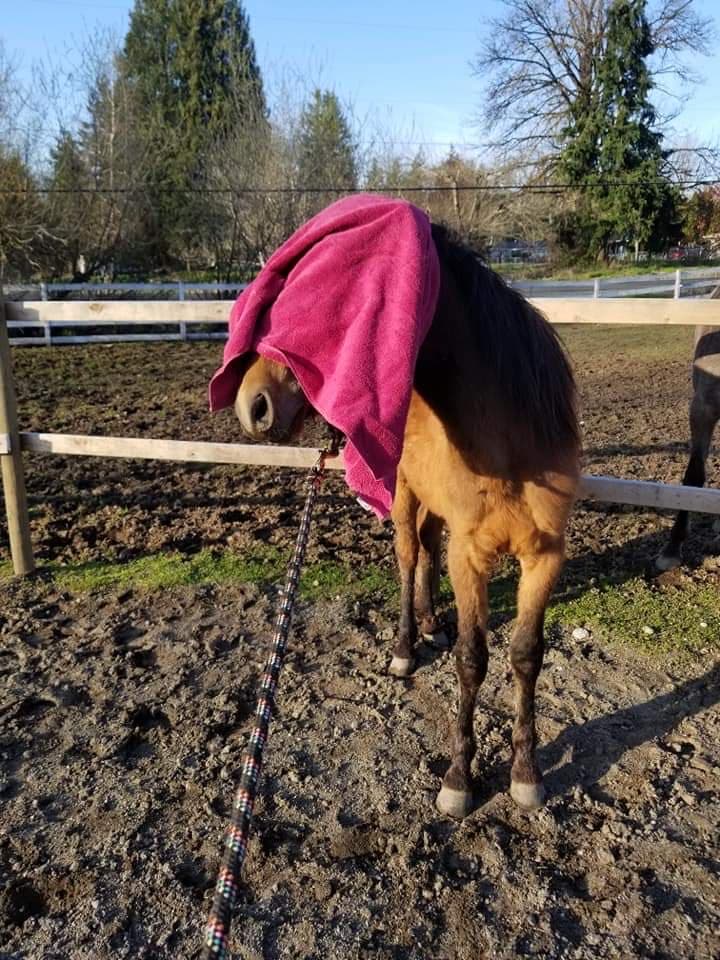
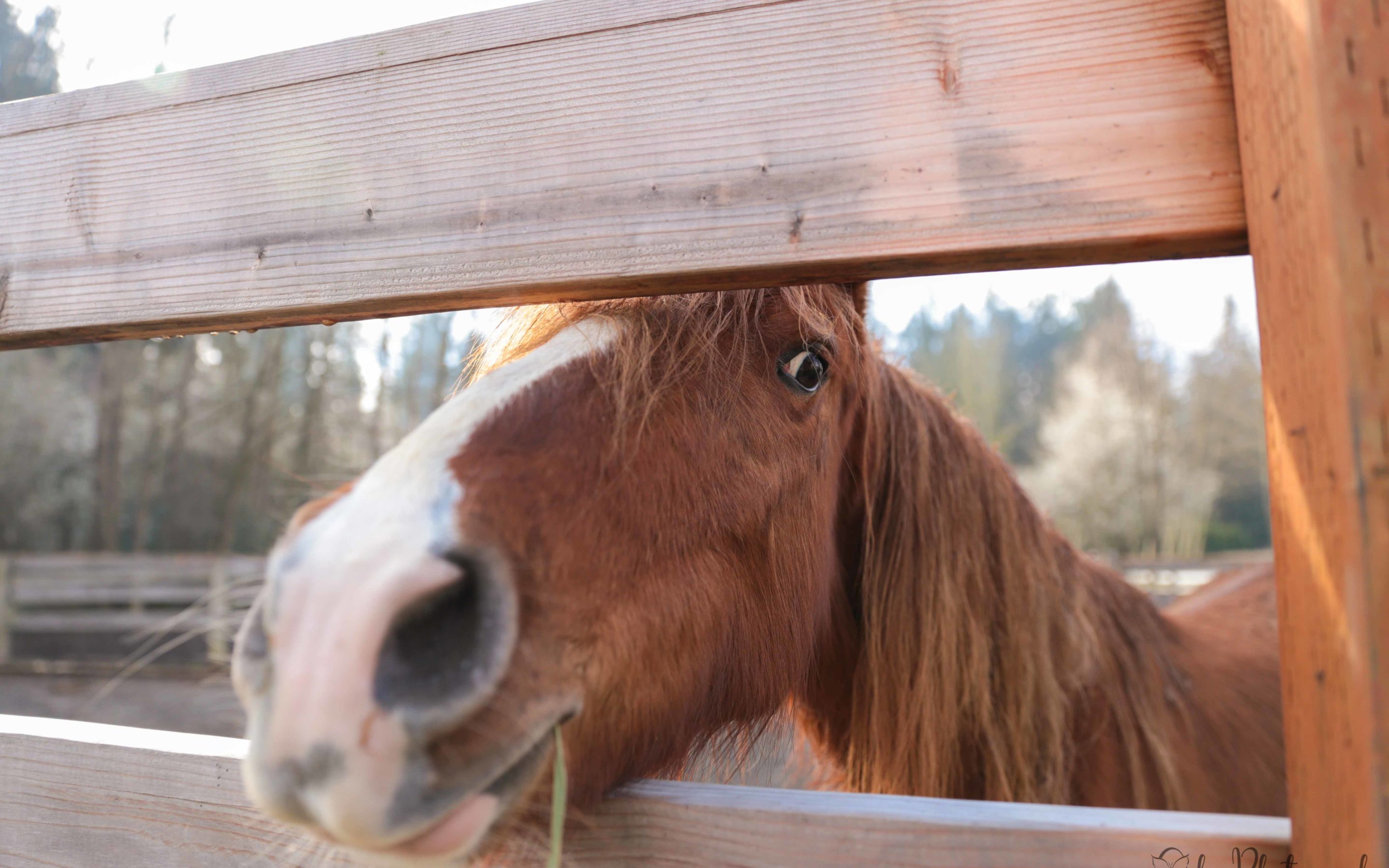
Fall City 40 Update
We started back in June with 40 horses…and we could not be happier that 30 of those horses are now in new homes, getting the care they need and deserve. That leaves ten horses who still need homes. You’ll notice that on the last update, we said that 11 horses are still available…things have REALLY slowed down with placing these horses. A couple adoptions fell through…the weather got ugly…and the public’s attention turned to other matters. Of course we knew we were in this for the long haul, but it’s been a while since we’ve even seen a good application for one of these horses. We’re really hoping that things will start to pick up now that the days are getting longer again. These horses are ready to start their new lives; are you ready to take one on?
For more on the Fall City 40, visit mayday.safehorses.org
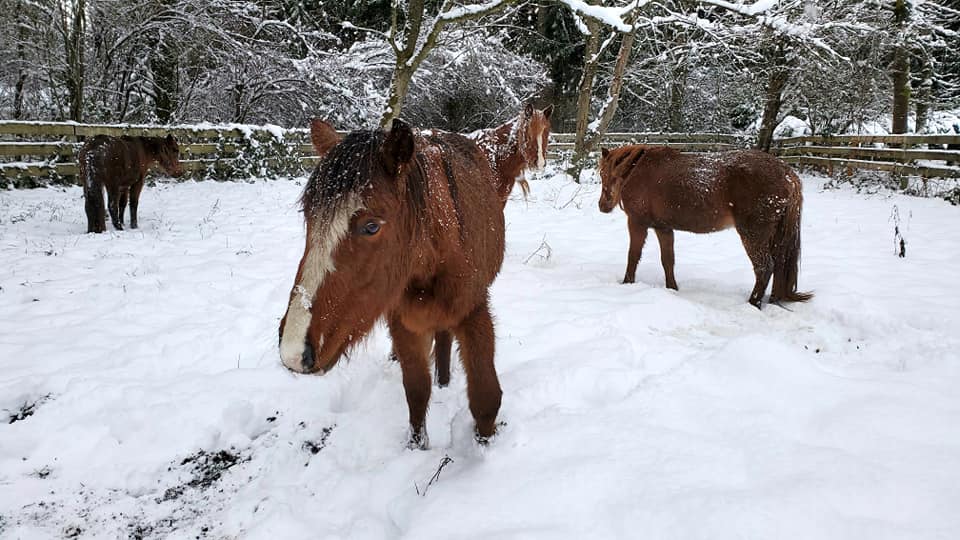
Fall City 40 Horses Update
If we’re being completely honest, taking on 24 wild horses in the dead of winter seemed like an impossible task, even to us. But we have successfully placed 11 of the seized horses into good homes with experiences handlers, and two more leave this week. That leaves 11 horses that are still available for adoption. Six of these horses are in foster homes where they are being handled, gentled, and halter-started. The other five are now at SAFE. We have handsome stallion Arty Shaw, and a group of four fillies. All five are getting accustomed to the presence of humans. They’re shy, but we’re encouraged to see that all of them are curious and interested in interacting with us. We’ve also noticed something wonderful: now that the four young mares do not have to worry about getting enough to eat, they spend time together playing like little kids. Here are some videos we captured during the recent snow:
Homes for the remaining 11 horses are still needed. If you have experience with unhandled, wild horses, please consider giving one of these beauties a home! Submit an adoption application here Adoption Application
Fall City 40 Update
It’s been about a month since the remaining Fall City 40 horses were seized in Enumclaw. These 24 horses have all been signed over to SAFE now, so we have full responsibility for their housing, feeding, and vet care, and we are taking steps to find homes for as many of them as possible. We are so grateful for the support we are receiving from this community to help us manage this huge rescue effort! It’s a lot of work, but with your help, we are making big changes for these horses!
Keep up to date with the horses at their website: http://mayday.safehorses.org
With regular feeding, the horses are starting to look and feel a lot better. There are some really nice looking horses in this group with cute markings and decent conformation. We’ve even discovered some unexpected athletic ability (like jumping!) in one or two of them. Most of them at least seem open to the idea of sharing the world with humans, and are becoming more gentle already. Wild horses are a challenge, to be sure, but most of these horses were born into this herd, not in the wild, but not exactly in captivity either. So we hope the young ones especially will make an easier transition from wild to domesticated.
As of this moment, six of the 24 horses — four mares and two colts — have been moved to new homes. Several of the remaining horses are in the process of being sent to foster care with experienced trainers for gentling, which will make them much easier and safer to place into adopt. All of the stallions will soon be gelded, and we’re finding adopters who can take in mares who are likely to be pregnant. Progress is being made.
But this is a tough time of year to be placing horses, and these are horses who are especially tricky to place. So we still need our community’s help with this rescue effort. Specifically, what we need includes:
• adopters who have experience with wild, unhandled horses
• trainers willing to foster and gentle one of these horses so we can place them more easily
• donations for the considerable cost for care, feeding, housing, vet costs, and transport of these horses
• people keeping an eye out for the missing mare, stolen by the owner, and for other groups of horses possibly owned by the same individual
We’ve also received some questions about the group of horses located in Auburn WA that were owned by the same person who owned the Fall City Forty. Those horses, about 50 in all, now belong to the owner of the Auburn property, and she is offering them for sale at $800 per horse to try to recoup her losses. There are several ponies, mini horses, and foals in this group, several colored horses as well. We believe that these horses came from feedlots and auction houses, so they are not wild horses. But they have not received much handling in the last year, so they will still need gentling and training. If you are interested in buying one of these horses, contact Dee Bowman at BnGRanchLLC@gmail.com SAFE has offered to cover the cost of gelding any of the stallions in this herd on behalf of their new owners.
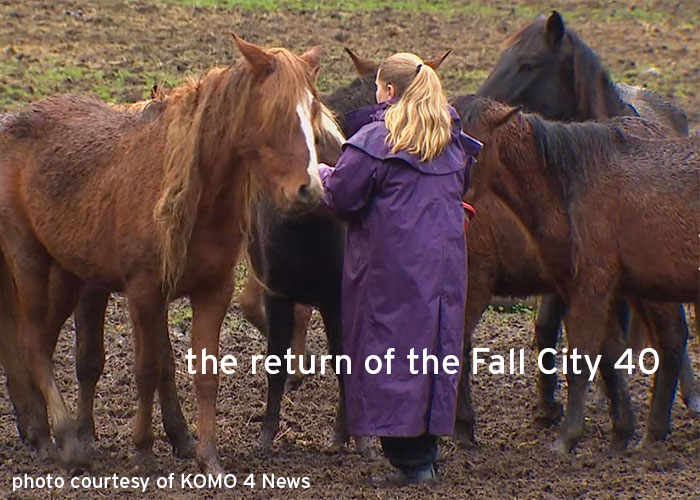
Horses Rescued in Enumclaw
Answers to FAQs
• yes, these are the horses we called the Fall City 40
• these horses are in a secure location, with food, water, and shelter
• these horses are in sheriff’s custody now, but will be signed over to SAFE soon
• SAFE is covering the cost of their board, feed, and vet care with money raised for the Fall City 40
• these horses will be available for adoption to people who have experience with unhandled horses
• stallions will be gelded prior to adoption and adopters will be responsible for after care
• visit http://mayday.safehorses.org for further updates
As was reported on several local news outlets over the weekend, SAFE was involved in a large seizure of horses by the King County Sheriff’s Office. At this time, all we can say is that the horses are in a safe and secure location with food, water, and shelter, and that they will be held there pending this active cruelty investigation. SAFE has taken on responsibility for the cost of their shelter, feeding, and vet needs, and is covering those costs with funds raised during the summer for the rescue of the Fall City Forty. We are accepting donations to our general fund for ongoing needs of all the horses in our care. We thank you sincerely for your support with this operation and your sincere concern about the well-being of these animals.
If you know the location of any other horses belonging to the individual mentioned in the news stories below, please contact us immediately, and we will pass that information on to the King County Sheriff. It’s vitally important that any remaining horses belonging to this person are tracked down and accounted for. Thank you for your help with this effort!
More information on this case:
KIRO TV story: https://www.kiro7.com/video/?id=4802680
KING TV story: https://www.king5.com/article/news/local/king-county-horses-rescued-enumclaw/281-c4c10b75-cdba-4d28-bf0a-db34d75a1176
KOMO TV story: https://komonews.com/news/local/22-horses-seized-as-king-co-investigates-nonprofit-for-animal-cruelty
Q13 TV story: https://q13fox.com/2019/12/09/22-horses-rescued-from-horrid-living-conditions-in-enumclaw/
Redmond Reporter: More than 100 horses are being hoarded by a nonprofit in Puget Sound
Redmond Reporter: More than 100 horses are being hoarded by a nonprofit in Puget Sound
Under guise of nonprofit caring for rescued horses, allegations of animal cruelty arose.
By Aaron Kunkler and Ashley Hiruko
Friday, September 6, 2019 8:30am
No one really knows how many horses Sharon Hunter has. Hunter, who owns and operates the Hunters Wind Wild Horse Rescue, had as many as 120 horses in two separate herds at one time. She stowed them on properties in Puget Sound counties.
Hunter’s Redmond-based nonprofit was founded in 2015, with just more than a dozen rescued horses from the Yakama Nation reservation in Eastern Washington. Since then, several of her horses have been seized by authorities alleging neglect in three counties, and in two counties horses have been euthanized. Horse advocates believe she may have more.
The nonprofit’s impact can be felt beyond the mossy pastures of King, Snohomish and Pierce counties. It stretches across the country to horse rescues in the Louisiana flatlands and in the dusty kill pens of Texas — the last stop for unwanted horses before slaughter.
Whether Hunter’s nonprofit is a net positive depends on who you ask.
(When contacted by phone for this story, Hunter hung up. She did not answer a follow-up phone call and an email received no reply. The civil attorney representing Hunter has not returned a request for comment as of the Reporter’s deadline.)
A Good Start
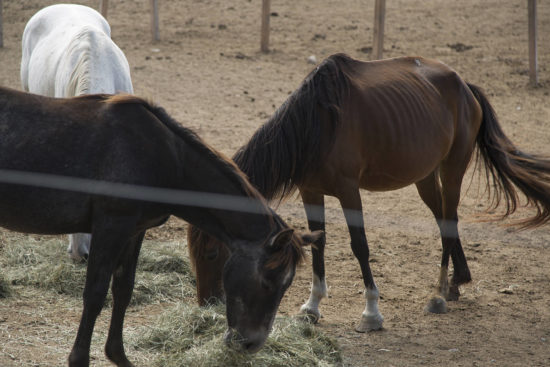
One of Hunter’s herds, located in King County, is fed a batch of hay. Horses, like these, are being housed on properties in numerous counties. Landowners allege that their owner hasn’t provided enough food or medical attention. Ashley Hiruko/staff photo
Hunter originally appeared in pages of the Redmond Reporter in 2015, when she started rescuing horses with her daughter Brandelyn and her son-in-law Joe Tafoya. Hunter’s family had been rescuing horses for about two decades and in 2015, Hunter took in 13 wild horses from the Yakama Nation reservation.
Before they were rescued, the horses were slated to be shipped abroad — either to Canada or Mexico — and slaughtered for their meat, Hunter said. And the conditions the horses faced in the industry’s kill pens were horrific. While Hunter was originally planning to take in two horses, she ended up rescuing 13.
The horses arrived in generally poor shape, and the family said they provided medical care. Two mares arrived pregnant, but one of the colts didn’t survive. It had been born with too many health problems, Hunter said.
“He had lots of love,” she said in 2015. “We named him Black Beauty.”
Hunter’s plan at the time was to rescue, rehabilitate and release the horses. She said she was working on securing a 14,000-acre plot of land in Oregon for a horse sanctuary. Joe Tafoya was trying to get Washington state to permenantly end horse slaughter and close the kill pen industry pipelines.
But at some point in the last four years, the relationship between the Tafoyas and Hunter soured and the herd multiplied. Joe Tafoya said he and his wife no longer have regular contact with Hunter.
“My wife and I continue to rescue horses on our own privately. When [the Reporter published] the article, Sharon had actually just brought those 13 horses on my property and we were trying to get involved to help. Shortly after, we figured out that we wouldn’t be able to help or work with her,” Joe Tafoya said in an email.
By 2019, Hunter’s herd had swelled in size to at least 120, with known herds at a spot in Snohomish County and one in Auburn. Another was in Fall City this summer, before being relocated to Enumclaw. At least one cluster was in Pierce County. Court documents from King and Snohomish counties indicate that several of the horses also were purchased from kill pens before they could be slaughtered abroad.
Kill Pens
Far from the Pacific Northwest, Angels Grove Ranch sits in the wooded southeast of Louisiana — about an hour’s drive north of New Orleans, across the Lake Pontchartrain Causeway. Court documents show that Hunter had boarded 10 horses with Lisa Massimini’s Angels Grove Ranch and Horse Rescue.
Massimini said horses she boarded, belonging to Hunter, were brought over by someone previously boarding them in Texas.
An investigation report from King County stated that a detective contacted Massimini, who said Hunter had made a down payment for boarding and care of the horses in August 2017. Between that time and the end of January 2018, she said she hadn’t received any additional payments during the five months of care. Eventually, Hunter paid the boarding fees and the horses were picked up by a hauler from her Louisiana ranch.
“I don’t really know where they went after me,” Massimini said.
Several of Hunter’s horses originally came from the south, and in particular Louisiana and Texas. Both states have notable horse kill pens that funnel horses to be slaughtered abroad. The U.S. essentially outlawed the practice of slaughtering horses about 12 years ago when the U.S. Department of Agriculture’s annual funding to inspect domestic horse slaughter facilities was cut. The soft ban requires annual approval from Congress, which has been renewed each year except two.
The soft ban basically prohibits the USDA from inspecting horse processing plants, and meat can’t cross state lines without the inspections. But instead of ending horse slaughter, it simply created an industry known as kill buying — where buyers pick up unwanted horses and ship them to either Canada or Mexico. Across the border, they are slaughtered for meat.
Many of Hunter’s horses may have been bought with the intention of saving them from kill buyers, including the ones Hunter seemed to have purchased and then boarded at Massimini’s rescue. Snohomish County court documents list some of Hunter’s horses as coming from Bastrop, Louisiana, home to what Massimini called a notable kill lot.
“Really if you want to dig deep … It’s people like Sharon that are trying to get horses so they don’t cross the border and they don’t die,’” Massimini said.
However, Massimini said she was unaware of what Hunter did with the horses in Washington state, or how the herd Massimini boarded was treated when they left her care.
Craig Downer runs The Wild Horse Conspiracy, a Nevada-based organization focused on preserving wild American horse lineages. Downer wrote a message in support of Hunters Wind Wild Horse Rescue on Facebook, which was shared by the rescue.
When contacted by the Reporter, Downer said he hadn’t seen the herd in person, but was particularly interested in the Yakima horse lineage. Proper breeding, he said, was essential to preserve the herd’s genetics. Downer said he learned of Hunter’s rescue after she reached out to him on social media some years ago.
“I don’t claim to really know for sure,” Downer said. “Her heart seemed to be really for the horses… that was like No. 1, and (she was) willing to sacrifice her own comforts and money and everything to help these horses. I do believe that.”
The Humane Society tracks horses that pass through kill pens to be slaughtered abroad. In 2018, about 80,000 horses met that fate, with most heading to Mexico, said spokesperson Keith Dane. A horse can fetch some money, but mostly nets less than $1,000 a head from a slaughterhouse.
Kill pen operators often market the horses to concerned horse owners and rescues before shipping them off. Kill pen operators give people an ultimatum: buy the horse or let it get packed onto a crowded truck and slaughtered abroad for a profit.
While the low price for a horse sent to slaughter means it’s not a terribly lucrative industry, about a dozen large operations exist, Dane said. Smaller operators are working across the country too.
“The Midwest is sort of like the epicenter of where these kill pens are located,” he said.
The Humane Society supports the Safeguard American Food Exports Act, which if passed by Congress, would permanently outlaw horse slaughter in the United States and prohibit shipping horses abroad to be slaughtered. Dane argued that horses currently slated for slaughter could find homes in the United States. Dane points to the fact that in 2012, about 160,000 horses were being shipped to slaughter, twice as many as last year. If the United States could handle those 80,000 horses, it could provide for the other half, he said.
Other groups, such as the Animal Welfare Council, have penned opinion pieces questioning whether laws like the Safeguard American Food Exports Act would help.
“Surely swift humane euthanasia at a [government] regulated and inspected processing plant is a kinder end than starving to death,” the council wrote on its website.
It’s worth noting, however, that both Massimini and Downer said they were unaware of the felony animal cruelty charges Hunter is facing in King and Snohomish counties (as many as 10 charges). Pierce County also has an active investigation looking into Hunter.
Abuse Allegations
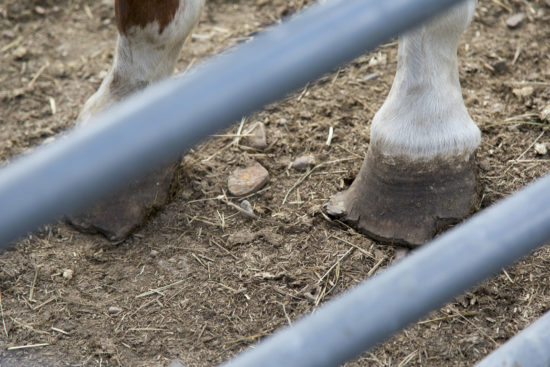
Horse hooves need to be trimmed on a regular basis and is a major task involved with horse management. Improper management of a horse’s hooves can lead to lameness. Ashley Hiruko/staff photo
On Feb. 5, 2018, Snohomish County Animal Services received a complaint about six troubled horses located on a property off of 153rd Avenue Southeast, about halfway between Maltby and Duvall. The report was made by the daughter of landowners who said they were approached by Hunter to board and lease at their pasture and barn. At first, two miniature horses and two full-size horses were brought to the property in January 2018.
The landowner had concerns about the animals’ health and asked Hunter to have a veterinarian visit. Court documents allege Hunter failed to do so. Animal control services obtained a search warrant, which allowed a veterinarian to examine the then six horses alongside law enforcement.
One pony named Lil Patches was found lying in his own feces and urine, unable to stand. The black-and-white pony was severely underweight and had chronic, untreated laminitis (an inflammation of the foot). The pony only stood on his own after receiving pain medicine.
Snohomish County seized Lil Patches, along with Miracle, a quarter horse mare with an untreated old wound that developed excessive tissue and blood vessels. Authorities also took Goldie, a palomino mare who was also severely underweight. It appeared Goldie was anemic and had a skin infection covering her entire body. These horses needed immediate medical attention, according to Snohomish County District Court documents.
The other three horses — Warrior, Willow and Princess — were in somewhat better shape and stayed on the property.
Snohomish County Animal Services manager Debby Zins said one horse was euthanized because of her condition. Another of the seized horses was initially rehabilitated and adopted out, but wound up being euthanized too. Only the third seized horse is still alive.
After the Snohomish County action, Hunter disappeared with her remaining three horses, moving them off the property to an unknown location, Zins said. The Snohomish County horses were originally moved to the 153rd Avenue site to avoid scrutiny from King County law enforcement, following a civil citation for animal cruelty, she added.
“We encourage anyone who knows where she is keeping horses, or if anyone has any of her horses or is concerned for her horses’ care, to please reach out to their local animal control agency,” Zins wrote in an email.
Later that month, Hunter was charged with six counts of second-degree animal cruelty in Snohomish County. If convicted, the felony counts would bar her from owning horses for a length of time determined by a judge. Her trial is scheduled for this month, but a continuance is possible.
Zins said she believes Hunter’s horse-centered nonprofit doesn’t function like others, in which horses are rehabilitated and then adopted out. Zins is only aware of Hunter collecting horses.
“Sharon Hunter is horse hoarding. Hoarding cases are complex and it is very difficult to break that cycle. She appears to be dedicated to her purpose, but is ill equipped to care for the animals and as a result many horses are neglected and suffering,” Zins wrote.
King and Pierce County Horses
Tim Anderson, lead animal control sergeant for Regional Animal Services of King County (RASKC), has been investigating Hunter’s Auburn herd of about 80 animals. The herd is in addition to another, known as the Fall City 40, which was moved to Enumclaw, and the Snohomish herd.
On Aug. 2, King County investigators moved in to inspect the Auburn herd, housed on a roughly 17-acre property. Four horses were ultimately seized.
Following that, Anderson said four civil notices of violation were issued on Aug. 17 for $500 each. The citations acted as the basis of four counts of second-degree animal cruelty charges recommended to the King County Prosecuting Attorney’s office on Sept. 1, Anderson said. However, the Reporter was not able to confirm those charges at the time of publication with the county prosecutor. If the charges are confirmed, it would bring the total number of felony charges Hunter is facing to 10.
In addition, Anderson said, a separate notice King County served Hunter on Aug. 17 would bar her from possessing horses within county lines for four years. She has about a month to comply or appeal. If not, Hunter could be fined $1,000 per day, per horse that is found in King County.
“She certainly has a lot of horses, more horses than she appears to be able to care for,” Anderson said.
The Auburn herd has dwindled to 65 from its peak of 80 after RASKC seized several horses and others were relocated to other properties. One of the horses was euthanized.
The pastures of the Auburn property have turned to dirt, due to the 65 horses housed on about 17 acres. Horses generally require between one to two acres per animal, according to Stable Management, an equine professional resource.
At the Auburn site, the horses are separated by sex and type, and within the last few weeks the property owner has begun supplementing and eventually fully feeding the horses. Many of the horses have cracked or chipped hooves and are in need of farrier services, dental work, de-worming and general vet care.
The Auburn property owner, who asked to remain anonymous due to fears of compromising ongoing legal matters, said Hunter had originally asked to pay rent and board for 12 horses on the property during spring 2018, a number that steadily ballooned to more than 80 by earlier this year. She said Hunter has intermittently provided the horses with food, but not enough to fully feed the large herd. Little headway has been made on relocating the horses, the property owner added.
“She has not adopted one horse out during the whole time,” she said. “When she starts getting in trouble she starts moving them around.”
Bonnie Hammond, executive director of the Redmond-based nonprofit Save A Forgotten Equine (SAFE), said they were willing to step in if the horses were declared abandoned, following a 15-day waiting period. However, on Sept. 3, the property owner said that Hunter was planning on removing the horses over the following days. During a phone interview with the property owner on Sept. 3, more King County animal control officers were onsite inspecting another horse that appeared malnourished.
While they can inspect, there’s little animal control can do under existing state or local laws to prevent someone from owning an abundance of horses. Law enforcement can only get involved when there are reports of animal cruelty or neglect, as animal control agencies in King, Snohomish and Pierce counties allege is the case with Hunter.
Owning too many horses comes with financial and time burdens. For example, SAFE’s program only accepts 30 horses at a time. And to care for that many horses the nonprofit requires 140 volunteers, five paid staff and a budget of about $650,000 each year, Hammond said.
SAFE has been involved in stepping in to care for several of Hunter’s herds, including the one in Auburn.
“Horses are hard to take care of and you need a lot of people, a lot of money, a lot of resources to properly take care of large groups of horses,” Hammond said.
In Pierce County, Animal Control supervisor Brian Boman said four horses were seized. Details are scarce during the ongoing investigation, but they are also Hunter’s horses.
Fall City 40
The Fall City 40 herd grew from the group of 13 wild horses previously housed just east of Redmond in 2015. At some point afterward, the horses relocated to the Johann family property in Fall City, a small town west of Snoqualmie. Jamie Johann-Barney is the daughter of the aging property owners, and said Hunter initially approached them by walking up their driveway and asking if they could board horses there.
Johann-Barney said the horses weren’t properly cared for and says her parents lost significant amounts of money boarding the horses. In June, she and others staged what Johann-Barney called an intervention, asking her father to get rid of the horses.
Law enforcement wouldn’t intervene, she said. Officers told them that since the family initially agreed to board the horses without a contract, it was a civil matter. SAFE, which later got involved, said the horses were allowed to breed freely, were not being fed, not receiving veterinarian or farrier care and not being adopted out.
“It was horrible,” Johann-Barney said.
According to SAFE’s website, the Johanns wanted the horses gone, but Hunter wouldn’t remove them. The Johanns sent a notice to Hunter in June saying she had 15 days to remove the horses or they would be considered abandoned. When the horses weren’t removed, the Johanns contacted SAFE, which helped get the horses healthy and assisted in their adoption.
The nonprofit provided hay, photographed and cataloged the herd, and tried to attract adopters, according to a post on the organization’s website that was also confirmed by Hammond.
Of the 40 horses, 15 were adopted out to new owners. But then an attorney representing Hunter served the Johanns with a cease and desist letter, demanding they stop trying to adopt out the horses. Hunter was also seeking to reclaim the horses in the letter. In the face of a possible lawsuit, the property owners decided to let Hunter remove the remaining 25 horses. Hunter also sent SAFE a similar letter demanding the 15 horses back that had been adopted. SAFE declined.
The remaining 25 from the herd were moved to another location, likely in Enumclaw, Hammond said.
“The truth is that she’s got groups of horses that she’s just shuffling from one place to another. Either she gets thrown off a property, or law enforcement’s getting too close or what have you,” Hammond said. “She’ll tell stories about saving America’s wild horses and all this really romantic stuff. But in truth, she’s just stockpiling them and they sit and they fight with each other and the stallions breed with the mares.”
Hammond was clear in what she would like to see happen.
“I would like her to stop acquiring horses,” Hammond said. “She needs to stop doing this and the scary thing is, there’s still plenty of horses out there. She could get them from the auctions by the truckload.”
A Hard Question
The situation presents a complex question: Is it better to let a horse bound for slaughter to die, or be adopted by individuals or organizations that are not fully equipped to care for the animals?
On the Auction Horses website, a plea is made. The message stands out from the rest of the content. Written in a bold font, in red letters at the top of the website, it reads: “Please NO fundraising for the purchase of horses.”
For Auction Horses, a Washington- and Oregon-based network of people who work to prevent the auction and slaughter of the animals, the message is an important one for the betterment of the animals, advocates say.
“People think, ‘Oh I’d like to give $20 to this good cause’…but if they don’t know where the horse is going and don’t know the person or their resources available to take care of the horses, they have no idea of the kind of situation they’re contributing to,” said Tash Johnson with Auction Horses.
Caring for a horse is a heavy endeavor. Costs are typically in the hundreds per month, and if the animals aren’t fed enough and their feet trimmed every six to eight weeks, horse health can decline.
“If you have 120 horses and you’re trying to feed them and take care of them, it’s an incredibly difficult task,” Johnson said. “Even taking care of them with staff.”
And things can get much worse in the winter, she said, when horses need extra food in order to stay warm and rain turns their pastures into mud pits. Attempting to move large bales of hay — generally 50 and 100 pounds each — becomes difficult in the rain, and hooves not properly cared for can become infected from feces on the ground.
“That’s what happens to neglected horses in Western Washington,” Johnson said.
She learned of Hunter when she relocated some of her horses to Redmond. Johnson’s horses stayed on a property nearby. Johnson said seeing a herd of horses with intact stallions and no separation from mares raised red flags.
When the man whose property Hunter’s horses were staying on started asking for help on the Auction Horses website, the red flags turned into “full-scale alarm,” Johnson said.
But she said having animals shipped off to slaughter is an “absolute failure.”
Johnson has seen every kind of horse end up on feedlots, the final stop before the slaughter: Champion horses sold when the summer ends by owners avoiding financial support during the winter; trail horses; best-of-the-best show horses; brut mares that could no longer get pregnant; ponies and draft horses and even young, healthy horses that went untrained.
She said the best practice for those concerned about the animals’ well being is to prevent them from getting to pens in the first place. Once there, the horses can become injured as they are mingling with dozens of other animals. And illness is brought in from different places. Johnson described the transportation of horses to slaughter, the way they’re handled, loaded into crowded vehicles and the slaughter pipeline as “horrific.”
“Rescue horses from Craigslist or posted on feed boards,” she said. “Save them before the kill pens. Once they’re in the kill pen, if there’s a good home for them, by all means save them. But if there isn’t, honestly, I would rather see them go to slaughter than suffer.”
Link to article online: http://www.redmond-reporter.com/news/more-than-100-horses-are-being-hoarded-by-a-nonprofit-in-puget-sound/
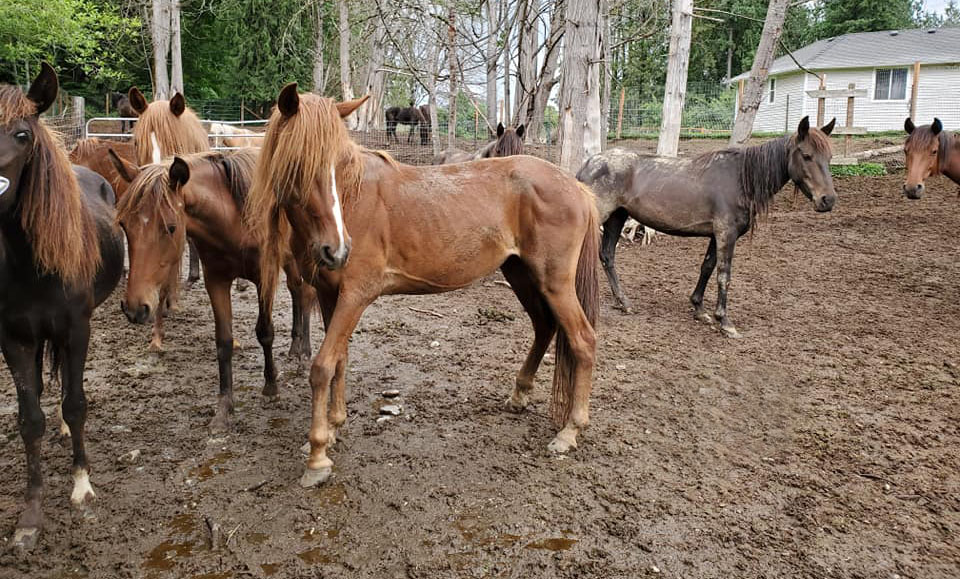
Fall City Forty: the Full Story
We’ve had to stay pretty quiet about the situation with the Fall City Forty for two reasons. One, because we were being threatened with legal action for our involvement in this rescue mission; and two, because we were holding out hope that we would be allowed to return to the Fall City property and continue caring for these horses. We feel it’s time to let our community know what happened, and what is continuing to happen.
First, some background. The horses we called the Fall City Forty were wild horses, originally rescued from Yakima. There were between 14 and 23 horses in the original herd, but because stallions and mares were turned out together and allowed to breed freely, the herd grew in size to the 40 that we encountered last June. While the owners of the Fall City property had originally agreed to let some horses live there temporarily, the situation had grown well out of hand: horses not being fed, not receiving vet or farrier care, not being gentled, handled, or trained, not being adopted to new homes. These horses were just being stockpiled, and all the while their owner was collecting more and more horses from auctions and feedlots.
The property owners wanted the horses gone, but their owner would not remove them. In late June, the property owners had a lawyer send notice to the horses’ owner that they had 15 days for the horses to be removed, after which time they would be considered abandoned under the law. The horses were not removed within the time allowed. The property owners then invited SAFE to come in and assist them in finding new homes for the 40 horses.
On behalf of the property owners, SAFE came in and began working with the horses. We had tons of hay delivered to the property so the horses could be fed 2–3 times per day. We photographed and cataloged the herd, and put the word out that we were looking for people who had experience with unhandled horses who might be willing to adopt them. And we began taking first steps toward gentling these wild animals and helping them become accustomed to being around humans.
Public support for this rescue effort was tremendous. Over 350 people made donations to help these horses and we received adoption applications from more than 40 people. We carefully selected those that that had prior experience working with wild, unhandled horses, and who had the resources necessary to provide regular and sufficient feed, veterinary and farrier care, and training. We conducted phone interviews with candidates to learn more about them and pair them with suitable horses from the herd. We did reference checks with veterinarians, trainers, and personal references. And we evaluated the suitability of new homes with photos and videos taken on site.
One week after we began working with the Fall City horses, a cease and desist letter from an attorney representing the horses’ previous owner was delivered to the property. The letter was addressed to both the property owners and to SAFE, and demanded that we cease our rescue efforts immediately. Because the property owners had taken the necessary steps to establish the herd as abandoned, we were not overly concerned about the cease and desist demands. But for our protection, we hired the same lawyer who drafted the 15 day demand letter for the property owners to represent SAFE, and we continued with our work on their behalf.
The next week, with the help a wonderful group of horsemen and women, we began preparing these horses for the next step in their journey towards better lives. Over the course of two days, 15 of the 40 horses were safely and calmly loaded onto trailers and sent off to new homes. Those who stayed behind continued to be gentled. We began strategizing the best and safest way to geld the many mature stallions who remained. This itself was not an easy problem to solve, but given time, we were confident that these stallions would no longer be capable of bringing more unwanted horses into the world.
It turned out that time was the one thing we no longer had. With the rescue operation in full swing and great progress being made, we were informed that rather than risk a lawsuit, the property owners had decided to try to settle with the horses’ former owner, and allow that individual to take the horses back. Although they were satisfied with the work that SAFE had done and the incredible progress we had made in a very short time, the property owners were no longer willing to fight for the well-being of these horses.
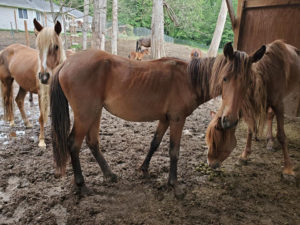 This was a crushing blow. It wasn’t just the work or the money that we put into this rescue effort. We’d come to care a great deal for these horses. We’d gotten to know them, given them names to suit their personalities, and started to earn their trust. We were deeply invested in helping all of them get new homes where they’d no longer go hungry. And we were SO CLOSE. The horses were getting healthy with regular feedings. We were winning the confidence of the shyest among them. We had more approved homes for them to go to, with people who genuinely wanted them. It was all going so well…and then it all came to a crashing halt.
This was a crushing blow. It wasn’t just the work or the money that we put into this rescue effort. We’d come to care a great deal for these horses. We’d gotten to know them, given them names to suit their personalities, and started to earn their trust. We were deeply invested in helping all of them get new homes where they’d no longer go hungry. And we were SO CLOSE. The horses were getting healthy with regular feedings. We were winning the confidence of the shyest among them. We had more approved homes for them to go to, with people who genuinely wanted them. It was all going so well…and then it all came to a crashing halt.
Immediately after the property owners gave up the fight, the attorney representing the horses’ owner came after SAFE, demanding the return of the horses that had been placed on behalf of the property owners and threatening lawsuits against us if we did not comply. We did not comply.
As for the rest of the Fall City horses, we held out hope until the very last minute that somehow we would be allowed back in to help them. But it was not to be. Our attempts to convince the horses’ owner to allow us to find new homes for the Fall City horses were ignored. And last week, their owner was able to move them to a new property. They remain in King County. They’re back to having to rely on their owner for care. Maybe this time things will be different…but based on past history, we remain very concerned about the well-being of these horses, and the many other horses owned by this same individual.
Thanks to the many people who helped with the Fall City Forty, we can take comfort in the fact that 15 of those 40 souls are safe. There is another large group of horses on a property in Auburn belonging to this person and we’re told that they are in the process of being evicted. So if you or someone you know is approached by someone looking for help to quickly move a large group of horses, please feel free to contact us for advice.
Barb’s Friends:
1. Stephanie P.
2. Toby S.
3. Sherry & Mel R.
4. Whitney-Bear B.
5. ____________________
6._____________________
7. _____________________
8._____________________
9. _____________________
10._____________________
Every horse deserves at least ten friends! Even a small monthly donation can make a difference.

